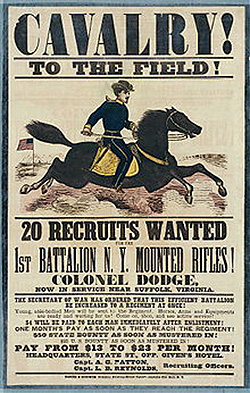
Please send all Checks and Money orders to :
Dave Taylor P.O. Box 87 Sylvania, OH 43560
419-842-1863
Click Here to E-mail Us!
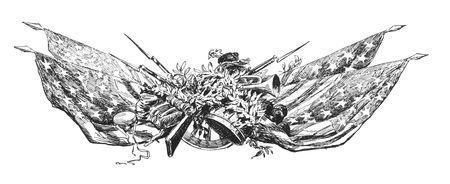
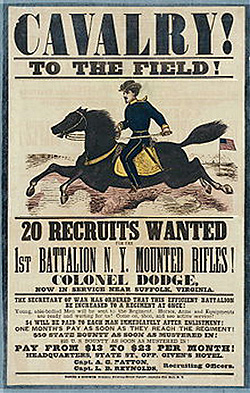
13 07
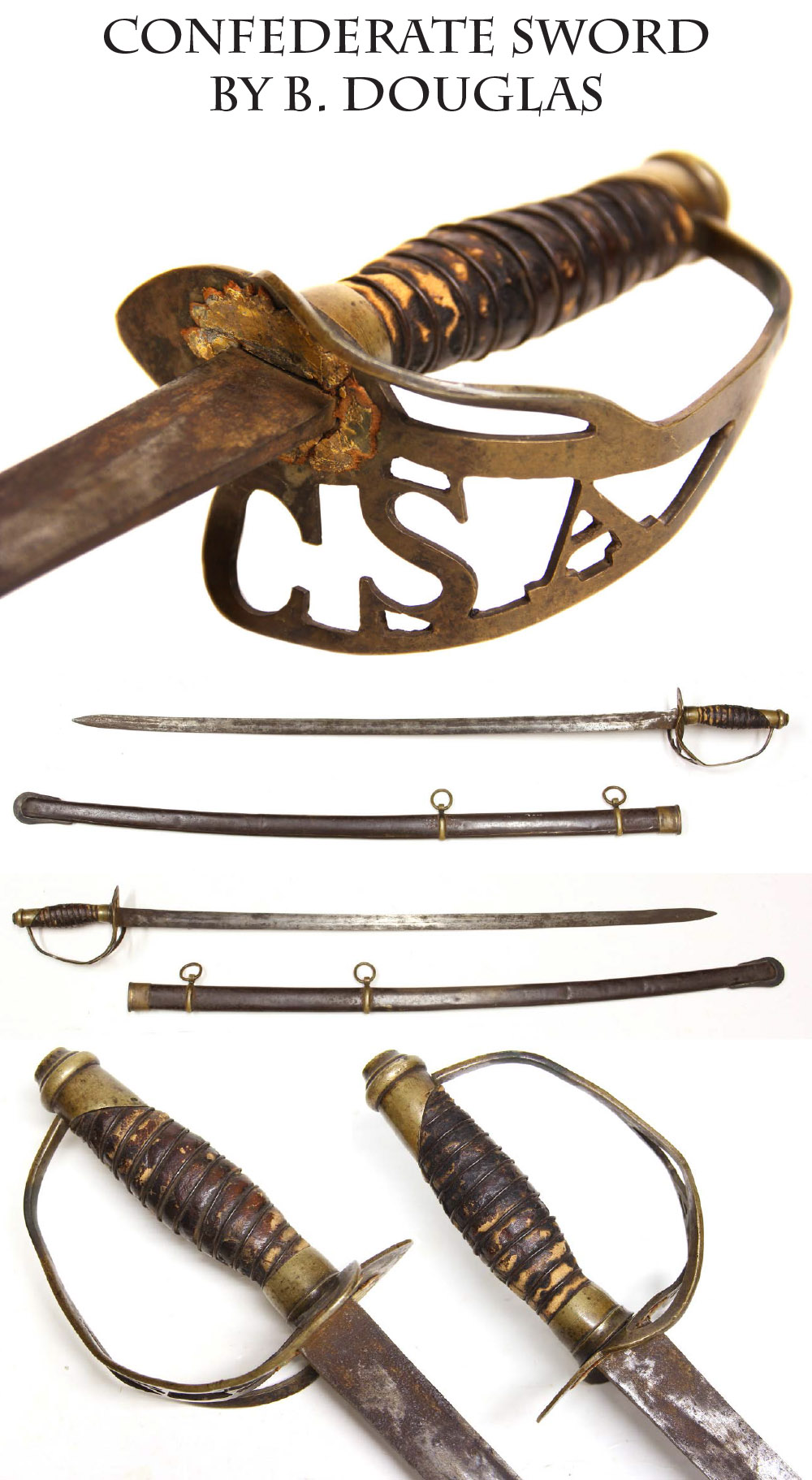
13-07-01 … 13-06-34 … Ultra Rare Confederate CSA Staff Officer’s Sword & Scabbard:
These wonderful swords with cut-out letters CSA in the guards are among the most sought of ALL Civil War swords. The guard screams CSA in giant capital letters. This pattern is virtually identical to the Confederate States Armory swords of the same design. They were believed for decades (1950s through early 21st century) to have been a variant product of the Louis Froelich Confederate States Armory staff sword, but it is now accepted by most collectors that this version may actually be the product of B. Douglas and Company of Columbia, South Carolina. I personally have not seen the data supporting this hypothesis, though heard that one was found marked by Douglas. Personally I have reason to believe that all or part of these variant “Douglas” swords may have actually been made by Boyle and Gamble in Richmond… based on features I have observed on the brass mounted steel scabbards. But that discussion can be saved for later. The bottom line is that it is an incredibly scarce Confederate CSA marked officer’s sword. The differences between this sword and the known Confederate States Armory (Froelich) sword include this sword not having a “cut-out” to form a proper serif on the top of the letter “C” as seen on the known Froelich swords. Douglas swords do not bear Roman numeral assembly or batch numbers, and they are slightly lighter with subtle changes in grip, ferrule, and pommel architecture. This sword is in very good condition. The grip retains the original wire and wrap, showing just expected handling wear. The brass guard is wonderful with the giant CSA letters staring us square in the face. Very attractive patina, very solid, slight bends from wartime use. Still present at the hilt is the starburst shaped leather bumper or washer. It is delicate but still present. The blade is overall grey steel with areas of surface rust. I have elected to leave the rust alone. When found the scabbard was lacking the drag so I sent the scabbard to our preferred swordsmith and he restored the drag making it a slightly different profile to show it is a restoration. I first saw this sword years ago… and the owner would not sell it. I followed up numerous times by email … every two or three months I wrote again… until he finally relented. In September 2012 the twin brother to this sword with a married Froelich scabbard with Roman numerals was sold by James D. Julia Auctions for $23,000.00.
Link:
James D. Julia Auctions
… My example is every bit as nice, mine has the proper scabbard without numerals, and it is truly a wonderful value at
… $18,000.00 SOLD
Click Here to E-mail Us!
Call us @ 419-842-1863

13-07-02 … 13-06-35 … 7th Ohio Volunteer Cavalry Identified Martial Whitney Revolver. A dead-on identified cavalry revolver! …
This Whitney has an absolutely real, period name stamped on the underside of the barrel in large individual letters: LEMUEL BOYCE. Matching initials are stamped on the bottom of the butt strap: L.A.B. Finding the owner was a piece of cake. There is only one match and he turns up very readily: Lemuel Boyce, Co. M, 7th OVC, Ohio Volunteer Cavalry. Boyce enlisted at age 30 on 10/10/62 and mustered into Co. M of the 7th Ohio as a private the same day. He mustered out 5/30/65 at Camp Dennison, Oh. The regiment mustered in during the Fall of 1862 and served in Kentucky and Tennessee, in the Army and Department of Ohio, and the Division of the Mississippi in the Army of Kentucky, the 23rd Army Corps and the Cavalry Corps. Civil War Data lists 69 entries for engagements. A detachment fought at Carters Station in December capturing 273 Confederates, an artillery piece, and destroyed a railroad bridge and train of cars. They fought at Mt. Sterling in March, 1863, and at Duttons Hill launched two charges. At Mill Springs they helped defeat Pegram, and were complimented by Burnside for actions at Rocky Gap. They fought against Morgan, and received the surrender of the Confederate garrison at Cumberland Gap, and participated in the final charge at Blue Springs. They lost 112 men at the defeat in Rogersville, were involved in the defense of Knoxville and pursuit of the enemy, fighting at Beans Station and cutting its way through the enemy at Dandridge. It helped defeat the enemy at Fair Garden and at Cynthiana, Ky., again faced Morgan, capturing a large number of prisoners. At Franklin it held the left of the line and at Nashville launched a charge by squadrons and captured four artillery pieces. Mustering out in July 1865, its total casualties were 560 killed, wounded, missing, prisoners and died of disease. The gun itself is a solid well used example in Very Good condition.
It is a Whitney .36 caliber six-shot navy revolver with matching serial numbers of 18304. Metal and wood tight. Metal overall mottled gray mixed with dark spots. A little brown rising here and there but no pitting and no significant dings. Wood very good, a couple minor dings on the underside of the butt and one tiny chip at back corner. Mechanically good. No cylinder scene visible, slight drag line present there. A second model, 4th type serial range, but with 1st type wing nut on the cylinder pin. Clear E. Whitney / N. Haven barrel markings, a little rubbed on the bottom edge. Trigger guard tang screw shows some roughness, other screws okay. Sight firmly in place. Nice patina to brass, some age spots. Overall a real war veteran, used but not abused. Whitneys solid frame made it a sturdier pistol and his products were strong competitors to Colt. About 30,000 of these were made in various models and about half were government or state military purchases. Here is one with a REAL and very tangible battle history in the Civil War
… $2,350.00 SOLD
Click Here to E-mail Us!
Call us @ 419-842-1863

13-07-03 … 13-06-36 … 1830s-50s Marine Corps Musicians Sword:
These solid-brass hilted eagle pommel swords were unidentified for many years until Norm Flayderman turned up sketches of swords in the work books of the Widmann Sword Factory in Philadelphia. The books were brought by a workman of Widmanns to the Horstmann Company after Widmanns death in 1848 when Horstmann incorporated the Widmann operation into his own. In those sketches are the Marine Corps Sergeants sword and the Marine musicians sword made in two lengths: The were titled in the book the Marine Music sword and the Marine Music, Boy sword. Both show similar stylized solid brass eaglehead short swords. With no further documentation some feel that the design may in fact go back to the 1830s or even 1820s due to the early style of the eagle. Ours has a gently curved blade with a single broad fuller and a very narrow ricasso. I see no marks. The blade shows bright mixed with a very light gray. There are darker spots scattered in the upper areas, becoming more plentiful toward the tip. The hilt has a nice untouched deep patina, with a few scattered paint spots from being stored in someones garage or workshop for a couple of generations. Ours differs slightly from the Widmann-Horstmann sketches in having a D-guard rather than a P-guard, but we are in pretty much uncharted territory since no published regulations have turned up describing any of these USMC swords, just the sketches that uncle Norm found. The knuckle bow also has a slot for a sword knot, just the sort of ornamental touch one might expect on a musicians sword. This is classic Philadelphia style architecture on the grip and eagle pommel. Unmistakably Philadelphia. A scarce form of eaglehead, and a rare sword. No scabbard.
… $1,100.00 SOLD
Click Here to E-mail Us!
Call us @ 419-842-1863

13-07-04 … 13-06-37 … 2nd Kentucky Volunteer Infantry Inscribed Sword of Lieutenant Lamech Duval, Company D. Shiloh, Stones River, Chickamauga!
This is a real field used sword belonging to a soldier with an excitng combat record and three years of service in the field interrupted by just one twenty-day leave of absence. The sword is a regulation 1850 pattern foot officers sword not signed by maker. Black leather scabbard with brass mounts, higher quality than standard with full floral engraving both front and back of the scabbard mounts. The scabbard is solid, with some rubbing and expected wear. The mounts have a deeply aged and undisturbed rich brown patina. The small brass screws holding the drag and upper mount were lost at some point during the swords active life and were replaced with dead real period small iron screws that show aged corrosion. The upper mount actually shows a depressed dimple created when the iron screw was put in and tightened on the FACE of the mount NEAR THE INSCRIPTION. Only the owner of this sword would have been that pragmatic. (As anyone familiar with antique swords can testify, the small brass retaining screws frequently fell out of the leather sheathing, hence the number of swords we find missing their drags. The same is true with the pins and rivets holding tips on bayonet scabbards and the drags on short sword scabbards.) The hilt is very good. Like the mounts, it shows a nice patina with traces of gilt in recessed areas. The grip is fully intact, with full sharkskin wrap and wire, with expected wear commensurate with its field use. The blade is bright mixed with gray and some shadowy areas and darker areas at the tip, but showing fully the etching on both sides, floral motifs and trophies of arms, a US on one side and eagle on the other, the inboard side with the US being a little more worn. On the upper mount is beautifully engraved: Lieut. L. Duval / Co. D 2d Ky. Regt. in between flourishes top and bottom. (Lamech is a good Old Testament name. Two show up in Genesis: one is a descendant of Cain and though he is credited with the Song of the Sword, which is sort of appropriate here, I think Duvals parents more likely were thinking of the other Lamech, the father of Noah.) Although a lot of Kentuckians went over state lines to enlist while the state was trying to maintain the appearance of neutrality, it seems that, like just about everyone else in this regiment, Duval was actually an Ohioan. He was from Cincinnati and enrolled 17 May 1861 at Camp Clay in Pendleton, OH, and was mustered in as Third Sergeant of Co. D at age 23 on 11 June 1861. He made First Sergeant by 31 December 1861, and was commissioned Second Lieutenant in Co. D dating from 11 January 1862, and First Lieutenant 1 July 1862. His Captain was absent sick and Duval was in command of the company as a lieutenant for an entire year, from 23 October 1862 to 13 November 1863, when the captain resigned and Duval received a commission as Captain of Co. D at Bridgeport, Alabama, to date from 7 November 1863. Duval had not been absent from his company for any reason up until 17 December 1863, when he requested and was granted 20 days leave to return home and assist his parents, who were devastated by the death of a daughter. The request is touching and the endorsements from commanding officers show he was held in high regard. Duval returned to the regiment and served with them until the regiment mustered out 19 June 1864. The Second Kentucky mustered in 6/13/61 and served in the Department of Western Virginia, and the Army of the Ohio and the Army of the Cumberland, being assigned to the 2nd (Army of the Cumberland), 14th, 21st, and 4th Army Corps.
They left Cincinnati in July, 1861, and were engaged almost immediately in skirmishes in Western Virginia at Red House, where Co. D was one of five companies engaged, Guyandote, Barboursville, Scarey Creek, and Gauley Bridge, Va. They wintered at Charlestown, Va., Bardstown, Ky., and Savannah, Tn. In April, 1862, when Duval was a Second Lieutenant and was carrying this sword, they marched to Pittsburg Landing, arriving at Shiloh on the evening of the first day, losing 2 wounded, and were then engaged heavily on the second day, suffering 16 killed and 20 wounded in the fighting. Ordered to attack a Confederate artillery battery, they were hit in the flank by two Confederate infantry regiments concealed in thick undergrowth, as their commander reported:
The fire was so severe that for a moment officers and men recoiled, but we soon rallied, and advanced step by step, supported on the right and left flanks by two regiments Gaining the edge of the thicket, the fight became almost hand to hand. Here the slaughter on both sides was terrible. Capt. Spellmeyer, Company C, fell dead with three fearful wounds. Capt.’s Rodine and Smith, Adjutant Weinedel, and Lieut.’s Miller and Alms were carried to the rear, all seriously wounded, and within a space of 30 yards fell over 200 of the enemy. Driving them from the thicket, they rallied around the battery stationed on a small hill directly in front of us. With a cheer our men went up the hill, and in ten minutes had possession of the battery. We held it but a few minutes, when the enemy, re-enforced by two regiments, advanced upon us, and we were compelled to retire. In retiring we were attacked by a large body of the enemy, who made a desperate effort to obtain possession of our colors, but fighting our way through to the right we emerged from the thickest of the contest with about one-third of the regiment, but with our colors safe, although riddled with grape and musket-balls. We remained outside of the fight until the men were again rallied, when Capt. Fry, assistant adjutant-general, of Gen. Buell’s staff, ordered us forward to the support of a battery that had engaged one on the enemy’s side. We remained acting as support but a few moments, when, with a portion of Col. Dunham’s Indiana regiment, we charged the enemy’s battery, routing them completely and securing their guns, one of which I had run to the rear and spiked, and the rest were turned upon the enemy’s cavalry, who were observed retreating in great numbers through the woods on our right. We remained on the ground thus obtained until several regiments joined us, when I withdrew and joined our brigade. END BATTLE REPORT: Following Shiloh, they were at the siege of Corinth, Buells campaign in Alabama and Tennessee and the pursuit of Bragg into Kentucky, the battle of Perryville and the march to Nashville. They regiment suffered some losses against Forrests cavalry in mid year, and were again heavily engaged at the end of the year at Stones River. At Stones River Duval was a First Lieutenant commanding his company, losing 10 killed or mortally wounded, and another 57 wounded. The regimental commanders official reports make great reading. At Stones River the regiment was one of two assigned to hold the advanced line of the division. Driving back Confederates early on Dec. 31, they were forced to fall back when neighboring troops retreated. By this time the enemy commenced emerging in heavy force from the woods in our front and on the right, and advanced in column, driving my skirmishers back to the front line. They moved forward in splendid style until they reached the crest of the first hill in our front there halted and delivered a well-directed volley full upon us. Capt.’s Standart’s battery immediately on my right and my two regiments in front (this includes the 2nd KY), simultaneously opened upon them, and with such effect that their front line gave way and fled to the rear; another line was forced up to the same position only to share the same fate; again fresh troops were advanced to the same point in the most perfect order. They planted their colors in the ground, and then extended their line by deploying to the right and left. The entire line threw themselves upon the ground and at once opened upon us and kept up a murderous fire.
The regiment held out until neighboring troops again fell back. Our position at this moment was one of great peril and danger. The enemy having driven back to brigade on our left, and gained possession of the high grounds around the burnt house, had there posted a battery, one section of which was turned on our position, hurling with fearful accuracy perfect showers of grape and shell. On the right they had pressed closely upon the retiring forces of Gen. Negley, and had gained a point within 150 yards of our position, when Capt. Standart, wheeling one section of his battery to the right opened upon them with such effect that they were checked, but immediately opened upon our position a terrible fire of musketry. Meanwhile their batteries and infantry in our front kept up an incessant firing. Thus we were completely exposed to an enfilading fire of artillery, and musketry, rendering our position untenable, and our capture or annihilation almost certain if we remained. The men, however, stood up nobly, preventing several different attempts to gain our position from the front. Out of ammunition, the regiment was again obliged to move to the rear, though not without rescuing three abandoned artillery pieces on its way back. During the second days fighting, the regiment supporting an artillery battery and was under counter battery fire from Confederate guns. From the time our forces left Nashville up to this date my regiment has been in the advance, never in reserve; and on all occasions, and under all circumstances, both men and officers have performed nobly and heroically the task allotted them.
In September, 1863, they were again in heavy combat at Chickamauga, as part of Crufts brigade, Palmers Division, fighting in chaos of Brock Field against Wrights Tennessee Brigade and suffering another 12 killed and 33 wounded. Even when hit in the flank and forced back by Sheffields Alabama brigade late in the day they managed to take 15 Confederates prisoner while falling back, and eventually leave the field in good formation. The regiment was also at Chattanooga, and detachments were at Ringold, Dalton, Rocky Face Ridge, etc. Ordered home in June, it even took part in operations against Morgan in Kentucky before mustering out, having lost 165 men in service, including 3 officers and 74 men killed in action or mortally wounded.
I close with Duvals letter requesting leave after almost three years of uninterrupted service (the muster rolls confirm this.)
To Gen. Whipple brig commander.
Sir,
I have the honor to apply for leave of absence for twenty (20) days to visit my home at Cincinnati, Ohio, for the following reasons:
My parents are both lying ill, and have recently suffered a severe shock, caused by the death of a beloved daughter. I am an only son and they are entirely dependent on my exertions for protection, comfort, and maintenance. I have been in the service almost three years, during which time I have never been absent with or without leave.
With a knowledge of the suffering condition of my parents, I can no longer fulfill my duties as an officer, and it being my earnest desire to see my parents once more, I would most respectfully and earnestly request that this my petition be granted…
The acting brigade commander marked it not only Respectfully forwarded, but cordially approved. The regimental commander had noted: Approved and respectfully forwarded. I very seldom ask special personal favors yet if it were in my power to secure by any honorable means the favor Capt. Duvall asks for I would do [so.] His merits as an officer and [the] circumstances connected with his family entitle him to a leave if not incompatible with any contemplated movement. Fine praise indeed.
This is a real battle sword carried by an officer with active record and I am pleased to offer it. Duval was not an easy officer to research. His name was recorded in some records as Lemic, perhaps how he pronounced it. This was then transcribed wrongly into some official records as Lemie, which is actually the primary listing for him on the US National Park Service site. Duval applied for a pension in May, 1892, and there is undoubtedly a lot more information yet to be uncovered on this devoted officer. I obtained this sword at auction where it was described completely erroneously. Their researcher was apparently new to the task and did not know where to research our Kentucky hero. He apparently consulted only the civil war data site which does not contain this mans records, and ignored the US Government records where the history resides completely. That was lucky for me (and you for that matter) as I was likely the only person bidding who actually knew the wonderful history. It did not cost me as much as I was prepared to spend. A most historic sword that truly saw real combat service in the big battles in the Western Theater. This sword was carried in more battles than most inscribed swords I have owned
… $3,500.00 SOLD
Click Here to E-mail Us!
Call us @ 419-842-1863
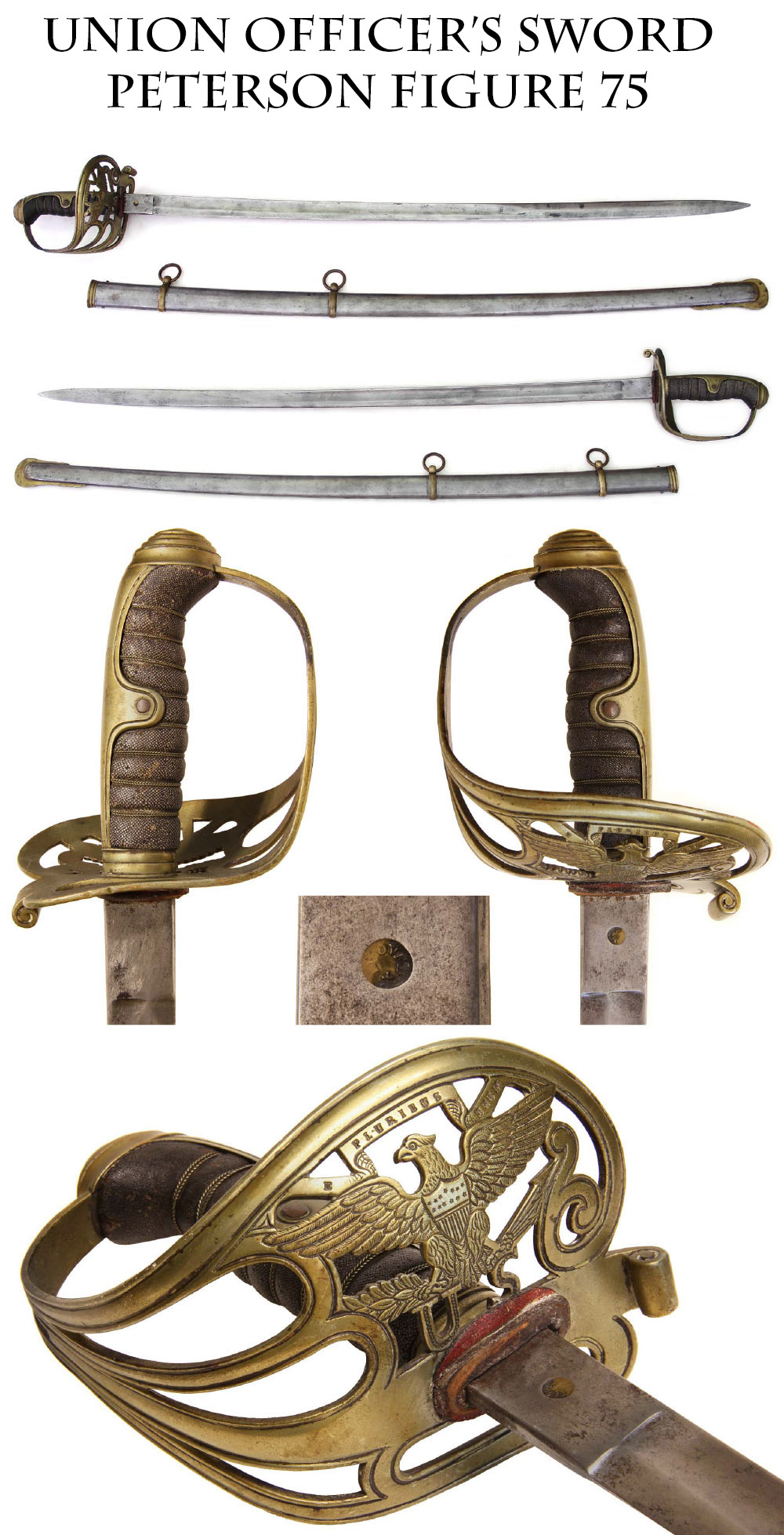
13-07-05 … Brass Mounted Peterson-75 Officers Sword and Scabbard:
These non-regulation officers swords were imported in large numbers and worn actively on field service because of their hearty construction and tough steel scabbards. They appear in numerous variant forms and are a collecting field in themselves. A few years ago Man at Arms Magazine had an article devoted to just a few of the variations we encounter. They were modeled on a British pattern officers sword and produced by a number of German makers to be marketed to US officers by military goods dealers during the Civil War. Collectors call them Peterson-75s from the designation Harold Peterson used in his classic reference book The American Sword. It was illustration number 75 in his book just that simple. This one is especially striking with a brass mounted scabbard (throat, carrying rings, and drag) and a brass guard, pommel and back strap with ears, all with incised line borders. The sharkskin wrap is complete, as is the wire binding, with acceptable wear on the outboard side where the palm of ones hand would rub it while grasping the sword. The brass has an even light, mellow tone, undisturbed. The guard is the usual openwork found on this pattern, with a striking spread-winged eagle, ribband with national motto above, and the cut-out letters US below, the letters with a central dot pattern and the eagle nicely detailed with incised feathers, shield on breast, etc. Pads in place at shoulder of blade. Small inset brass disk at ricasso reading proved. Blade is an even silvery gray with some grayer cloudy areas and a couple of dark spots. No pitting. Unetched. Scabbard matches, no dents. A very classy sword meant to withstand hard use in the field. Some take the eagle and US to indicate use only by field officers, but identified examples show they were used by officers of every rank in all branches of service, both mounted and foot. Even Phil Sheridan carried one for a while! I know because I once owned his sword and sold it. This would look great with an officers sword belt and sash, or could be carefully used in living history. Compare with the prices of the tourist town dealers Darn fair at
$895.00 SOLD
Click Here to E-mail Us!
Call us @ 419-842-1863
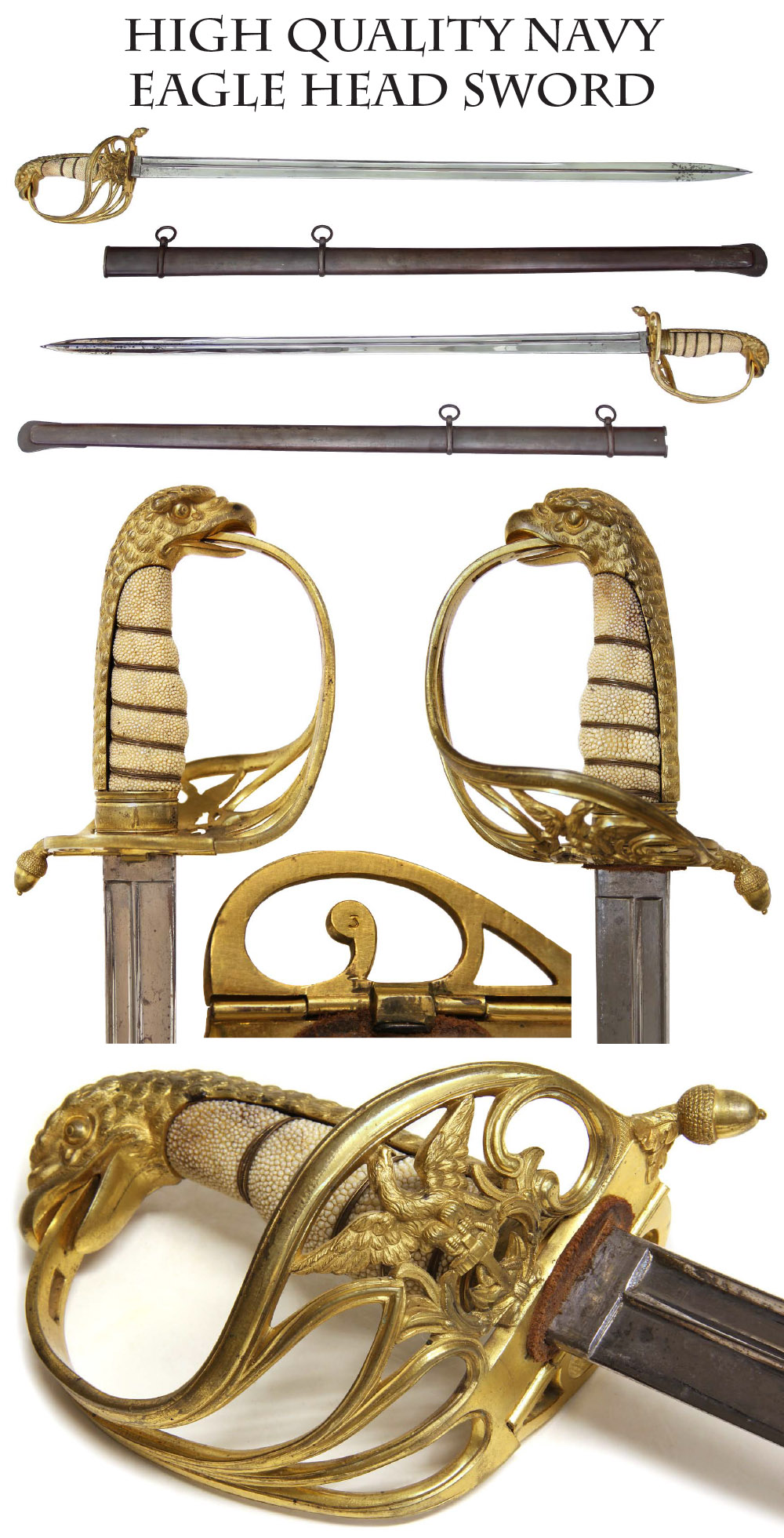
13-07-06 … Highest Quality Most Attractive Eagle Pommel – Excellent Condition – Non-Regulation Civil War Navy Officers Sword:
When I saw this sword I had to have it- a very showy non-regulation pattern US Navy officers eagle pommel sword and scabbard. This sword preserves the essential elements of the 1841 USN officers pattern- particularly the magnificently ferocious eagles head pommel and a folding guard on the inboard side. Peterson shows one as Number 139 and dates it circa 1850-65. His was a relic. This one is great! Lots of gilt left on the brass mounts, straight fluted blade showing bright and no nicks, just some age toning as an unpolished silver and some darker spots near the tip. Correct full metal scabbard showing a faded plum brown, carrying rings, and throat notched for the folding guard hinge. No dents or dings. Full white ray or sharkskin grip wrap, a little dirt near pommel, full wire binding in place. Gorgeous acorn finial quillon and long-necked spread-winged eagle perched atop an anchor in the guard amid swirling floral guard branches, curling its neck upward and looking like it wants to burst out of there. All with lots of original gilt. Beautiful eagle with prominent round eyes on the pommel, slight age darkening patina here and there. The sword works as an artistic whole and is quite striking in my opinion the BEST eagle pommel one can find on a naval sword. Blade has the long medial ridge running from a short ricasso out to the point, creating a rectangular fuller below the spine on the back edge, as well as a back edge near the spear point tip. A really great piece for the sword collector as well as the Navy enthusiast. It will be a while before another like this turns up. I was visiting an old friend for the purpose of buying some antiques we had a pretty good pile put together but I wanted this eagle head in the pile too. He finally priced it to me at $3000 and I growled at him and said OK. I just had to have it One heck of a sword
$3,500.00
Click Here to E-mail Us!
Call us @ 419-842-1863
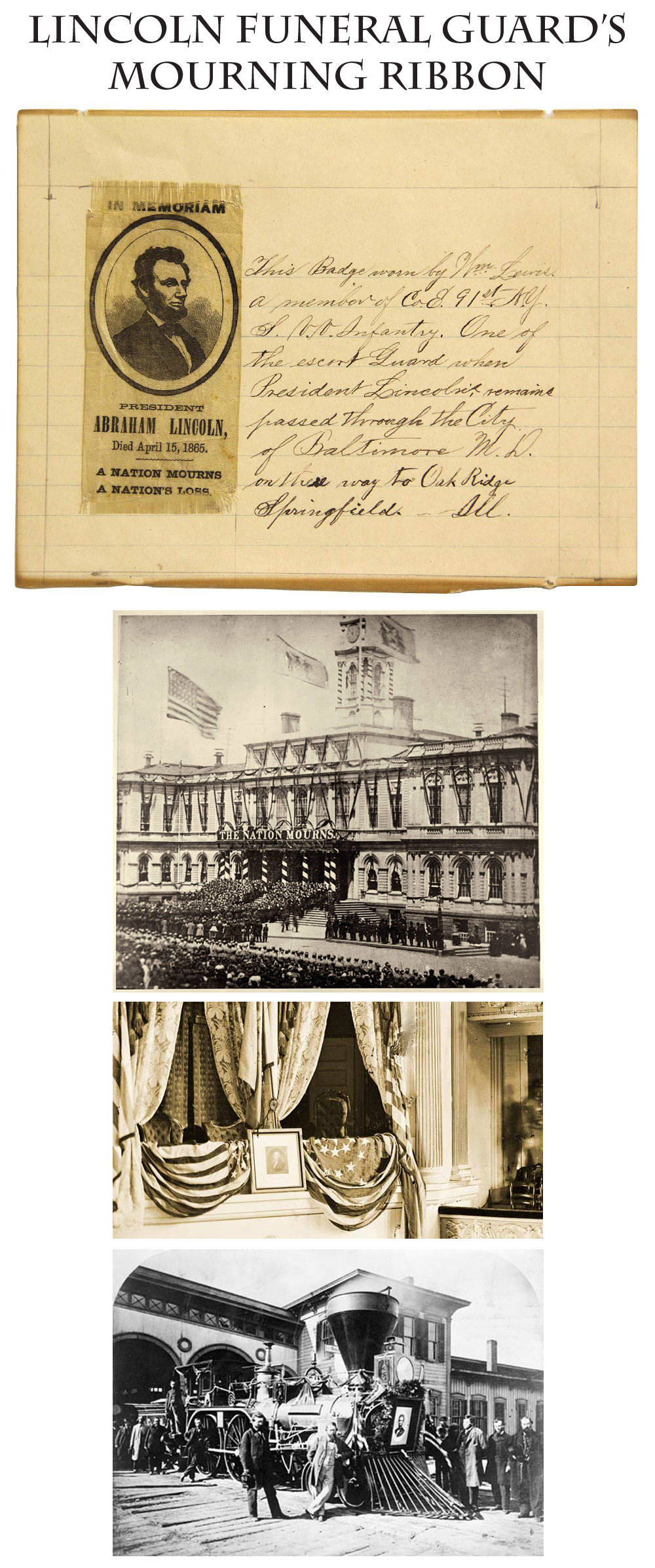
13-07-07 … Genuine Lincoln Funeral Guard Mourning Ribbon w/ Wonderful Documentation:
We see Lincoln mourning ribbons fairly regularly on the market. They were preserved as mementos of a beloved President. But few are documented as to ownership, and virtually none are documented to use by one of the actual funeral escort. Lincolns body was sent through several large cities so that he could be honored by the citizens before he was interred in Springfield, and this ribbon was worn by a guard in Baltimore. This is a silk ribbon with black oval bust portrait of Lincoln in the upper third with the words, IN MEMORIAM above, and his name and death date below, and at the bottom edge the motto: A NATION MOURNS / A NATIONS LOSS. This was mounted on a lined album page and its history penned next to it recording its wear by William Lewis, Co. E, 91st NY Veteran Volunteer Infantry, This Badge worn by Wm. Lewis, a member of Co. E, 91st NYSVV Infantry. One of the escort Guard when President Lincolns remains passed through the City of Baltimore M.D. on their way to Oak Ridge Springfield Ill. The badge shows minor fraying on the top and bottom edges, into the upper and lower lines of text, but leaving them very legible. The inscription was either written by Lewis himself or a family member or friend during the years immediately following the assassination. The ancient manuscript letter truly makes the ribbon the wonderful historical relic that it is. William Lewis enlisted in 91st New York at Albany at age 21 on 9/5/64 and was mustered into Co. E as a private the same day. The 91st served from December, 1861, to July, 1865, mostly in the 19th Corps in the Army and Department of the Gulf, where it fought at Irish Bend and Port Hudson, serving as heavy artillery during that siege. Williams joined the unit when it came north in 1864 and reenlisted as a veteran regiment, being assigned to the 8th Corps in Baltimore from October, 1864. Company E was detailed to remain in Baltimore when the other companies were directed to join the Army of the Potomac in the field, and thus was in a position to act as honor guard for the Presidential funeral procession as it made its way through the city and the lying-in-state. Baltimore was the first stop of the funeral train, which arrived at 10:00 A.M. on April 21, 1865, two hours after leaving Washington, DC. The Presidents body was then escorted to the Merchants Exchange Building, where it lay in state for two hours for public viewing, before being taken next to Harrisburg, PA. The train carried also the body of Lincolns son Willie, who had died in 1862. It retraced the route Lincoln had taken to Washington as President-elect, and returned him to Springfield on May 3. William Lewis was mustered out 6/19/65 at Baltimore and, fortunately for us, kept this ribbon and documented it for posterity. A true piece of Lincoln Assassination history
… $950.00 SOLD
Click Here to E-mail Us!
Call us @ 419-842-1863

13-07-08 … Touching and Tragic Civil War Love Photos:
A fine ninth plate patriotic thermoplastic case starts out this little set. This was treasured and saved by an 1860s girl whose lover was killed in action. Inside are two images. Primary image is a handsome ninth plate tintype of Union soldier in cap and uniform with a note reading Jack / Lucias intend(ed) / Killed in Civil War. And behind the soldier image is a nice portrait of what appears to be Jacks mother. Scratched into the tin can be seen … .ck Crils??? … .ther which I take to read Jack Crils (or Curls or Cruls or ???) Mother. Perhaps if you look hard at the scratching you can see more than I do. Case is a superb Constitution and the Laws case in excellent condition.
Fine little lot that displays with great emotion
… $350.00 SOLD
Click Here to E-mail Us!
Call us @ 419-842-1863

13-07-09 … Presentation Engraved War Date 1860 Staff Officers Sword Presented to Surgeon:
This is the 1860 staff officers sword which is virtually impossible to find made pre 1865, a true rarity in military collectibles. This sword is etched with the US coat of arms, military trophies, and floral designs. The knuckle-bow has floral scrolls and thunderbolts, and the guard has an eagle and arms on one side, with the opposite hinged clam shell guard bearing a beautiful engraved inscription which reads Dr. Carr/from/Capt. Craig. This sword is missing the small ball, which helps keep the counter-guard either open or closed, but other than that is complete. I had helper Tom install a cosmetic ball for display purposes. The condition is very good The brass mounted steel scabbard is likewise VG showing just the right amount of age. The patina on the brass is rich, deep, undisturbed, and beautiful … the way you wish all your antique brass looked. As for our good Dr. and his friend Capt. Craig, I have found a handful of surgeons named Carr and a few Union Army captains named Craig. None of the possibles served in the same unit, so we will surmise that their relationship was professional with the gifted sword possibly for medical services rendered. I will leave the research project of determining which Dr. Carr and which Capt. Craig have the doctor – patient relationship. I am certain the relationship can be discovered but am equally certain that it will take a lot of hours of detective work to find it, hours that I do not have to spare at this end. … An extremely scarce sword
with a compelling and tantalizing inscription begging for research … a very fair deal at
… $1,750.00 SOLD
Click Here to E-mail Us!
Call us @ 419-842-1863

13-07-10 … Four Eagles for the Price of One!
War of 1812 period US officers eagle pommel sword. Bone gripped brass mounted saber not only with a great eagle head pommel, but two standing eagles with spread wings on the langets, and a fourth etched on the blade. Stirrup guard hilt with slot for sword knot, quillon with disk slightly downturned, original bone grips with a nice cream-colored patina still showing engraved lines top and bottom and faint cross-hatching that is probably checkering smoothed by years of handling. Grips are solid, only one narrow line and one slight chip on one side at the lower ferrule. Eagle on the pommel is the Philadelphia style crested eagle. Those on the langets are a very early style long-necked eagle looking very griffin-like, standing on a wreath that enfolds it on either side, and might date the sword somewhat pre-1812. The blade is curved with a single broad fuller, good edge and point, faint silver in color with some gray areas, profusely etched from the langets about 2/3 along the blade. Floral motifs on both sides of the blade, a trophy of arms on one side and on the other an eagle with American shield on its breast and ribband with motto above. The etching is certainly not frosted, but is very legible and traces of the original gilding remain in some of the etched lines near one langet.
This has a nice aged and mellow appearance, but is very showy with the number of eagles used to embellish it. I particularly like the those primitive looking ones on the langets, and so will you. No scabbard
… $695.00 SOLD
Click Here to E-mail Us!
Call us @ 419-842-1863
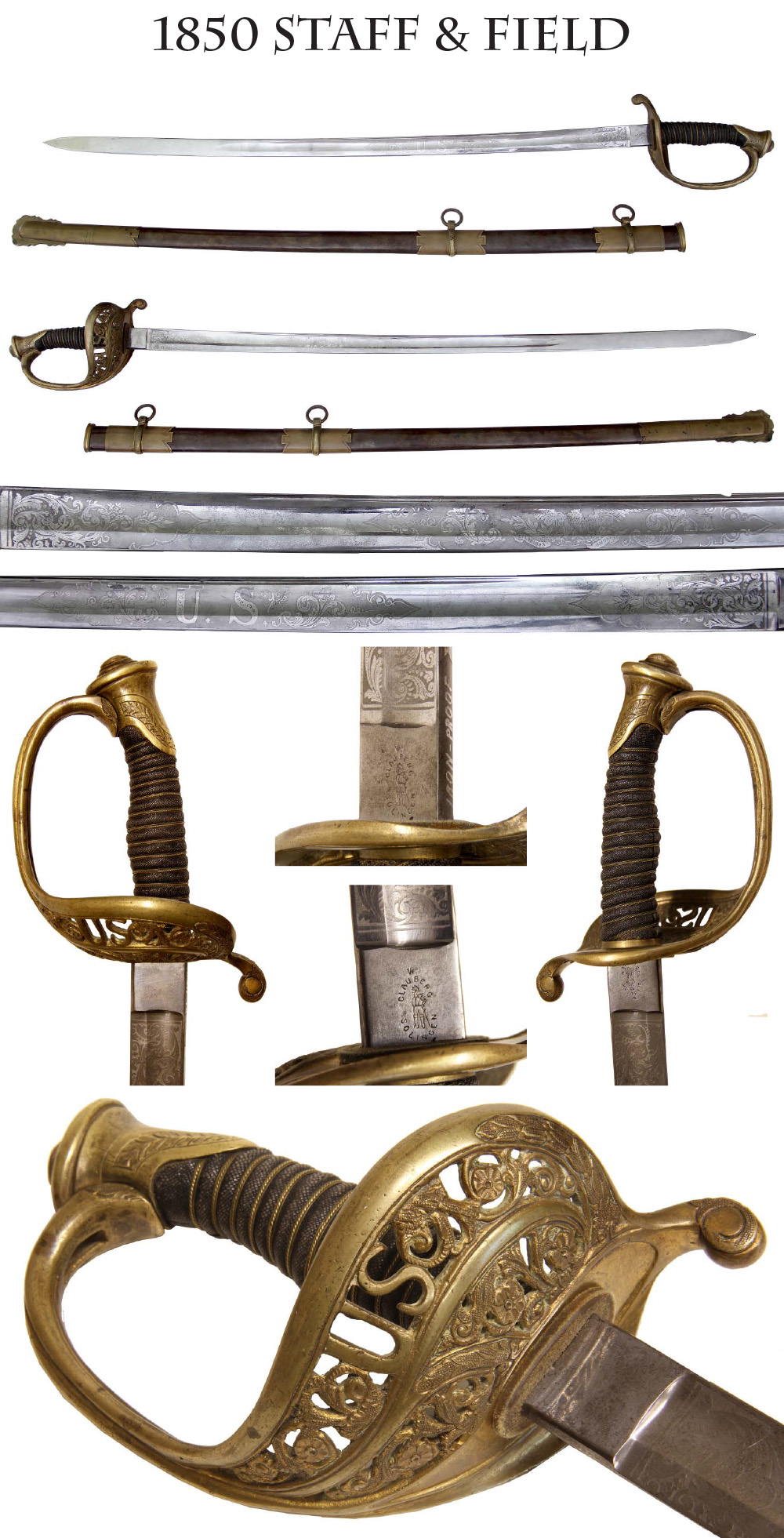
13-07-11 … Fine Condition Regulation 1850 Pattern Staff and Field Officers Sword.
This is the regulation sword for officers who rank major and above, including general officers, or who are on staff duty, such as regimental adjutants or aides-de-camp on a generals staff. Regulation brass hilt with floral motifs with a US amid them on the guard, showing traces of gilt in recessed areas, a nice mellow patina overall. Sharkskin grip and binding wire all there and in nice condition. Bumper pad in place at shoulder of blade. Blade bright with much luster and strong etching. Very attractive. No nicks. Both sides have etched panels at the ricasso and then separate etched panels midway up the blade with scrolling floral motifs, on one side surrounding an eagle with wings spread over a ribband with the national motto below and on the other side a prominent US. W. Clauberg / Solingen stamped at the ricasso around a standing knight. On the spine Iron Proof etched. A little minor graying on ricasso. Scabbard smooth and fine, blue now faded to an attractive light plum brown, brass mounts with nice patina. Separate throat, upper and middle mounts with carrying rings, and fancy drag with leaf profile edge. This is a sword the way you like to find it out of a house – just aged enough on the exterior to show it has not been messed with and then bright when drawn, showing it was well cared for. A key piece in an American edged weapons collection by famed maker Clauberg arguably the best European blade maker of the period
… $2,250.00 SOLD
Click Here to E-mail Us!
Call us @ 419-842-1863

13-07-12 … A great Rarity – U.S. Cavalry Officers Saber with a Rare Retractable Scabbard.
Officers liked the steel hilts and scabbards on the swords imported from European makers by American military goods dealers and frequently used them in the field. This is a high quality French made sword patterned on the British 1822 officers sword, single edged, extended spearpoint blade, wide central fuller and narrow partial back fuller, with a branched guard, regulation sharkskin grip. Grip shows wear on the inside where ones fingers would rub it. The original triple wire binding using coil and line is in place and tight. Ricasso shows typical proved brass disk insert and is etched with military and floral motifs. Etching is worn and shows up more as dark against the silver gray and dark spots, but the various floral and martial motifs, and a spread winged eagle on a ribband with E PLURIBUS UNUM is partially visible.
NOW THE GOOD PART- the scabbard is the EXTREMELY rare French made retractable scabbard
made in two telescoping spring-loaded sections that slide together when the sword is drawn in order to get it out of the users way. I have seen only a couple of these over the years and many advanced sword collectors have yet to snag one. Even John Thillman says he has only seen two! Throat is stamped Jay & Cie. / brevetes a Paris, roughly: Jay and Company, Patented in Paris. Excellent condition. There is a small red collection number from a long deceased Detroit collector, 75 B near the throat, and there is also some scratching on the very top of the pommel, which might be from handling or to mark out a set of initials.
This is a very cool sword appropriate for any officers display, but particularly for cavalry or other mounted officer, and is a hard-to-find trophy for the sword collector as well. One of the rarest and most interesting Civil War sabers I have owned
… $2,250.00
Click Here to E-mail Us!
Call us @ 419-842-1863
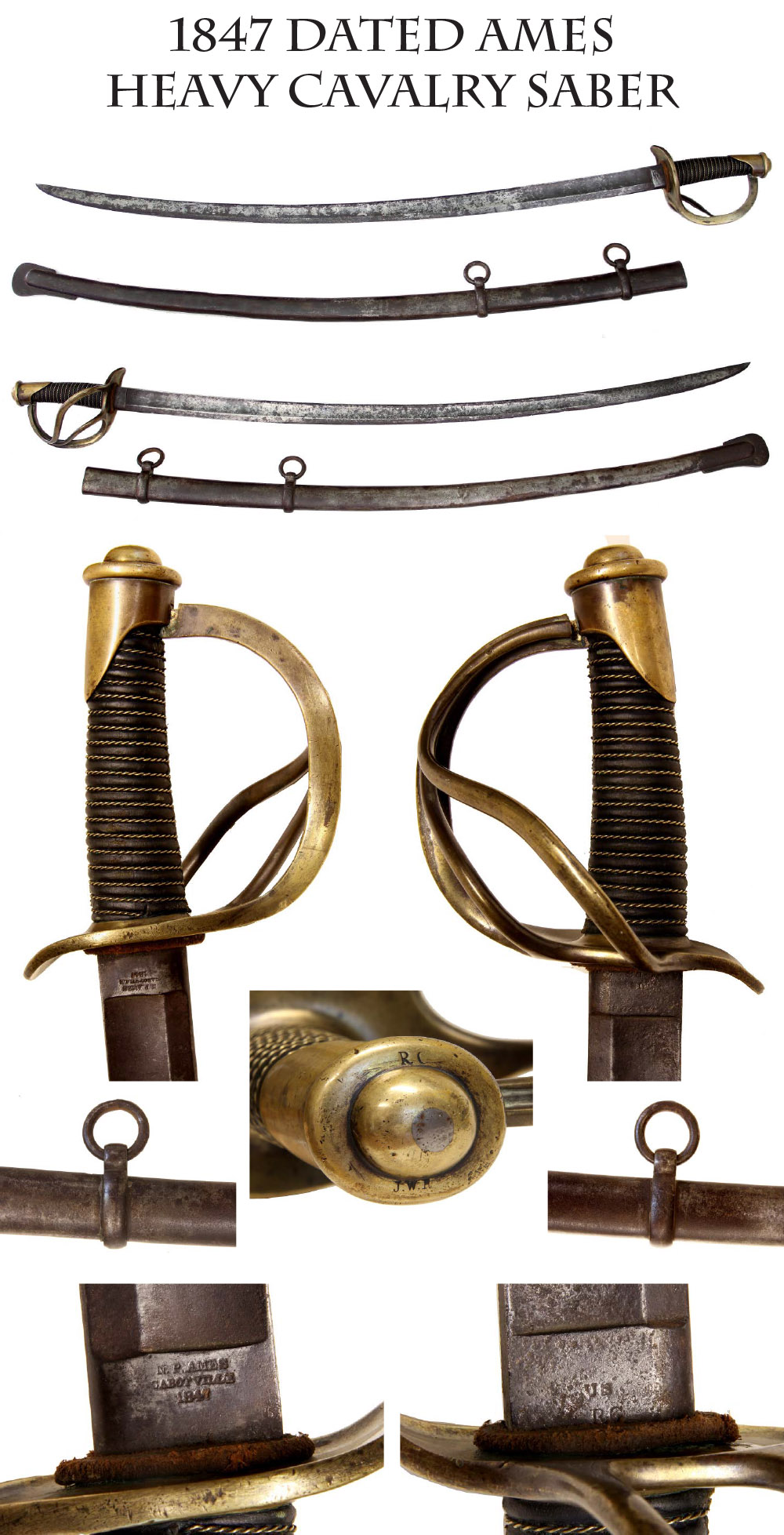
13-07-13 … Mexican War Dated Ames Heavy Dragoon Saber:
One of the scarcer US sabers to find are these Mexican War dated heavy cavalry examples. Blade is deeply marked with full Ames firm name and address, inspectors marks, and manufacture date of 1847. Scabbard is original and free from dents. Handle wrap and twisted wire is restored. Throat on scabbard is missing. Blade is grey and mottled. Here is a heck of a deal
… $650.00 SOLD
Click Here to E-mail Us!
Call us @ 419-842-1863
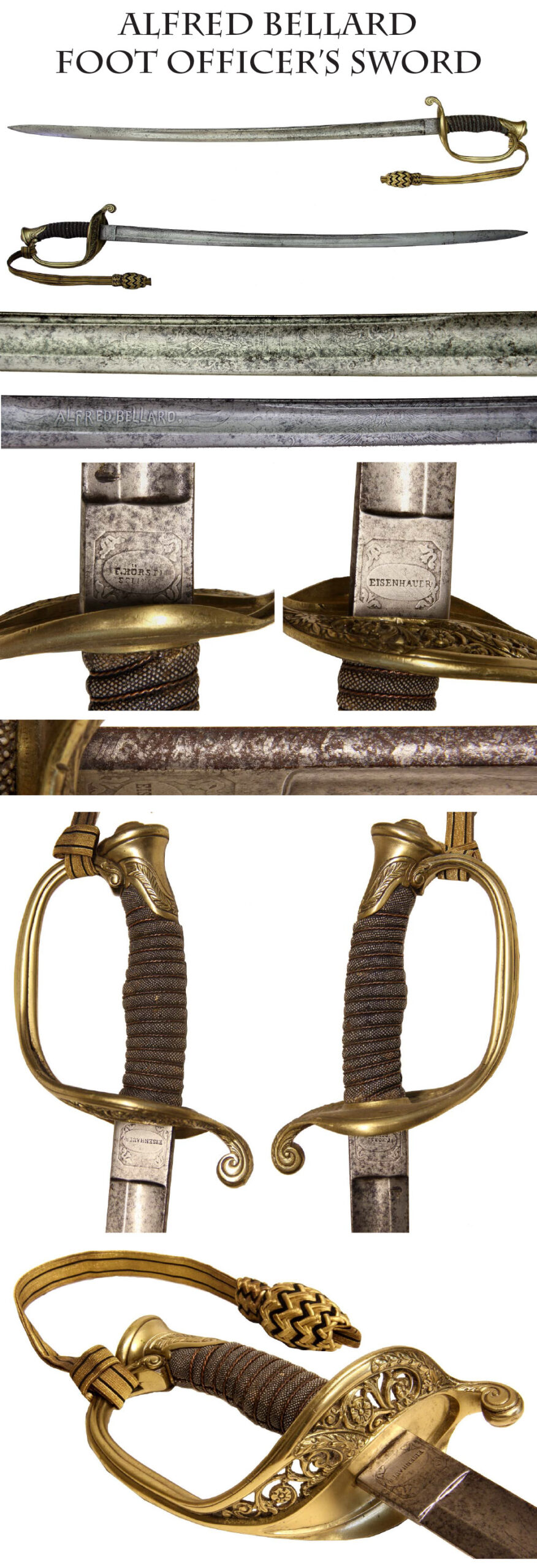
13-07-14 … Inscribed 5th New Jersey Sword owned by author of Gone for a Soldier — Alfred Bellard!
Born in 1843, Bellard joined the Fifth New Jersey and kept a journal that he illustrated with wonderful drawings and watercolors of his experiences. The journal rediscovered in 1962 and published in 1975 as Gone for a Soldier, it has become a classic in the Civil War community. Bellard saw action on the Peninsula, at Second Bull Run, Fredericksburg and Chancellorsville, where he was wounded in the leg and was eventually transferred to the VRC with whom he saw some further excitement in defending Washington against Early in 1864, before being discharged that Fall. He died in 1891.
The sword is an import 1850 foot officers sword by F. Horster of Solingen, and so marked on one side of the ricasso, with the quality assurance eisenhauer (tempered steel) on the other, both inside clipped corner square cartouches with floral motifs in the corners. An additional Iron Proof is etched on the back edge of the blade at the hilt. The sharkskin wrap of the grip is excellent, and the coil binding wire is in place, all with very little wear. A gold officers sword knot with acorn end is looped through the guard. The blade is good, a light silvery gray with scattered gray spots. Both sides and part of the back edge near the hilt are etched with geometric and floral motifs, one side including a U.S. and the other a striking spreadwinged eagle with American shield on its breast, resting on clouds with a spray of sun rays radiating out from behind it. Just down from the eagle is Alfred Bellard etched on a narrow floating banner with forked tail at either end.
Although Bellard is listed in available records as a private in the 5th NJ and the VRC. He is shown wearing the wide stripes of an NCO on his trousers in the full-standing photo of him that exists, and though not regulation, the carrying of an officers sword by a non-commissioned officer is not at all uncommon. This is a great memento of a very colorful character. New Jersey items are scarce and eagerly sought after. A copy of his book with this would be a compelling display. The story behind his coming into ownership of this sword is unknown to me, but I will wager that it is recorded in New Jersey archives somewhere.
No scabbard. Great sword knot
… $1,850.00 SOLD
Click Here to E-mail Us!
Call us @ 419-842-1863

13-07-15 … Pennsylvania Officers Set:
I obtained this lot of material directly from the family who told me that their ancestor served from Bucks County, Pennsylvania with the last name of Fretz. They did not know his first name nor unit. I have copies of my email correspondence with family. Civil War Data shows twelve Penna soldiers with the last name of Fretz. Of these only one fellow shows up from Bucks County. He is Edwin Fretz of the 104th Penna who rose through the ranks from sergeant to Lieutenant. He served from late 1861 through late 1864. He may well have been the owner but we do not know for absolute certain. It is certainly plausible as it was darn common for officers of meager financial means to carry common cavalry sabers. The pictures tell the story. We have a nice 1863 dated Ames cavalry saber and scabbard. A fine Union officers grade eagle buckle on remnants of a belt. And we have a set of flag tassels. An honest attic found lot of artifacts priced right.
As for the 104th Pennsylvania history … The 104th, all of whose members came from Bucks county except one company, was organized at Doylestown in Sept. and Oct., 1861, and mustered into the U. S. service for a three years, term. It proceeded to Washington on Nov. 7, and was quartered during the winter at Georgetown. As part of the 1st brigade, 3rd division, 4th corps, it took part in the siege of Yorktown early in 1862, and the actions at Savage Station and Fair Oaks. In the latter engagement the conduct of the regiment was most gallant, but it paid the penalty of the loss of many brave men. The regiment was in reserve during the Seven Days’ battles and arrived at Harrison’s landing on July 3. It was next stationed at Gloucester point through the autumn and there winter quarters were established, but on Dec. 28, the 104th was ordered to Beaufort, N. C. Soon afterward it proceeded to Hilton Head to join in the operations against Charleston. Camp was occupied on St. Helena island until April, 1863, when an unsuccessful movement against Charleston was made. The regiment then went into camp at Beaufort where it remained until July 6.
Leaving Beaufort, the regiment moved to Folly island and thence to James island to threaten Charleston by way of Secessionville. James island was held against the attack of the enemy on July 16, but the troops were withdrawn to Folly island the next day. In the siege of Fort Wagner which followed, much arduous duty was the portion of the troops and Aug. 29, the brigade was ordered to Morris island. The island was evacuated by the enemy early in September and the 104th was stationed there during the winter of 1863-64. In Dec., 1863, a large number of the regiment reenlisted. In June the troops concentrated for an attack upon Charleston, but encountered the enemy upon John’s island, which they were obliged to evacuate, and the expedition proved fruitless. The regiment then returned to Hilton Head, where it remained until the end of July, when it was ordered to Florida and guarded the railroad between Jacksonville and Baldwin for a month. A wonderful lot of items that really saw action in the Civil War
… $1,750.00
Click Here to E-mail Us!
Call us @ 419-842-1863
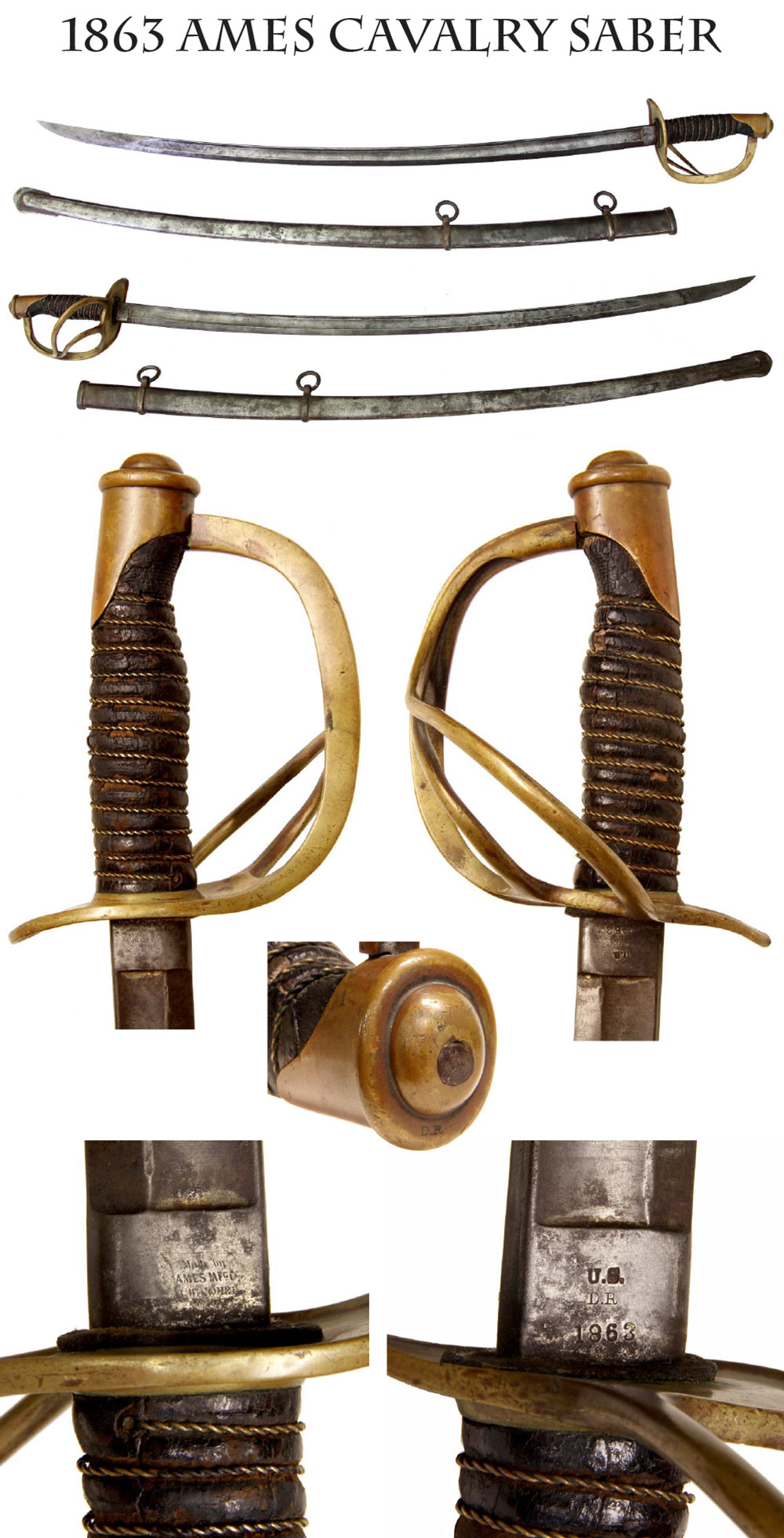
13-07-16 … Gettysburg Dated Ames Cavalry Saber:
A highly desirable example of the Union Army light cavalry saber bearing the full Ames firm markings, inspectors marks, and scarce date of 1863. Overall VG condition showing expected wear and handling. Brass guard is excellent with great color and clear inspectors initials. Leather & twisted wire wrap on the grip show considerable wear with some loss of leather but overall VG. Scabbard is overall gun metal grey patina with light surface texture and no dents. Inspectors initials visible on the drag. Rare date, Fair Price Perfect for a Custer at Gettysburg display
… $765.00 SOLD
Click Here to E-mail Us!
Call us @ 419-842-1863

13-07-17 … Very solid example of the regulation Union Army combat officers sword:
Just the sword no scabbard. Blade bears Fitch dealers name. VG grip with full shagreen and twisted wire. A real CW foot officers sword
… $495.00 SOLD
Click Here to E-mail Us!
Call us @ 419-842-1863
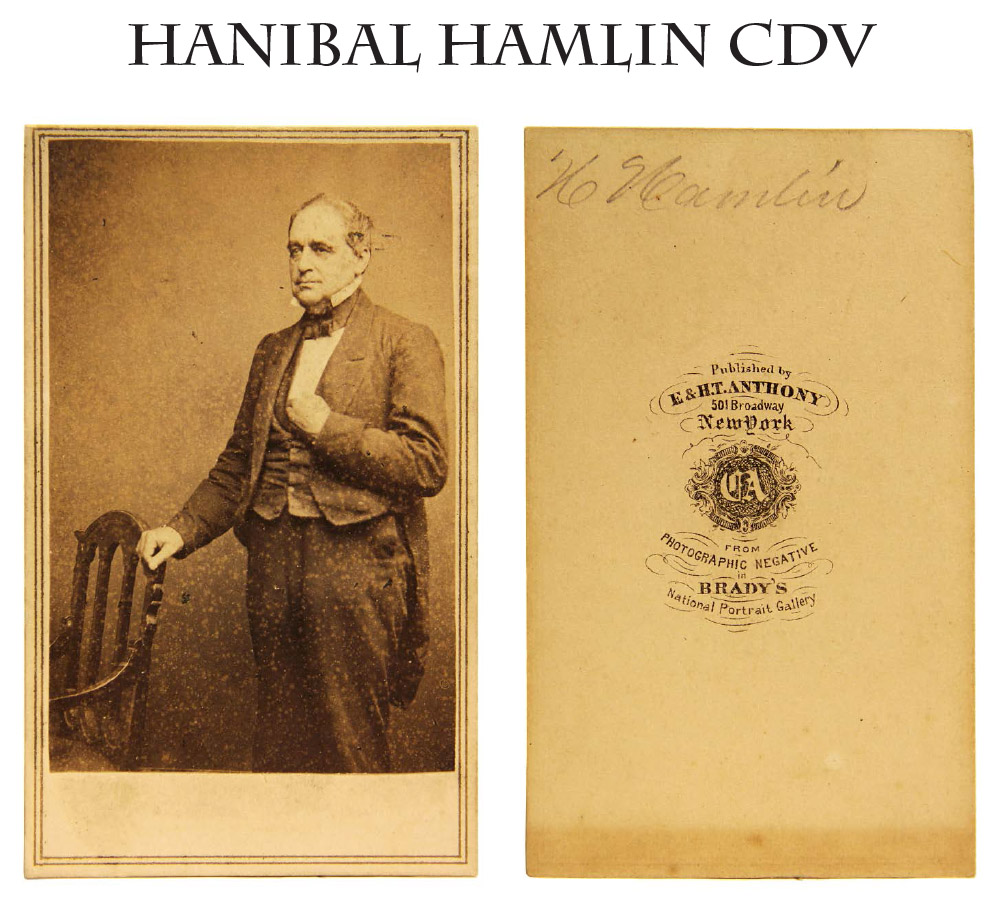
13-07-18 … Supremely Rare CDV Vice President Hanibal Hamlin:
In the 45 years I have collected Civil War photos I believe this is the first image I have had of Lincolns first Vice President. In 1861, Hamlin of Maine became Vice President under Lincoln whom he did not even meet until after the election. Maine was the first state in the Northeast to embrace the Republican Party, and the Lincoln-Hamlin ticket thus made sense in terms of regional balance. Hamlin was also a strong orator, and a known opponent of slavery. While serving as Vice President he urged both the Emancipation Proclamation and the arming of Black Americans. He strongly supported Joseph Hooker’s appointment as commander of the Army of the Potomac. When Lincoln was renominated, War Democrat Andrew Johnson of Tennessee was named to replace Hamlin as Lincoln’s running mate. Lincoln was seeking to broaden his base of support and was also looking ahead to Southern Reconstruction, at which Johnson had proven himself adept as war governor of occupied Tennessee. Hamlin, by contrast, was an ally of Northern radicals (who would later impeach Johnson). Lincoln and Johnson were elected in November 1864, and Hamlin’s term expired on March 4, 1865. In other words Hamlin served as Vice President for the entire Civil War except the last five weeks, and Johnson served as VP for only five weeks. This is a truly Super image, extremely rare, from life, with Matthew Brady Anthony back mark. A must for a display of Lincoln or War related images
… $595.00
Click Here to E-mail Us!
Call us @ 419-842-1863

13-07-19 … Quadruple Armed Confederate Officer:
Here is something you dont see every day … a Johnny reb officer with four weapons. Bowie in the belt, Colt in his belt, another Colt in his hand, other hand resting on the hilt of his sword. Sixth plate ambrotype housed in a full case. About as rare a subject as I have offered … I paid near this much for the privilege of obtaining this
… $2,850.00 SOLD
Click Here to E-mail Us!
Call us @ 419-842-1863
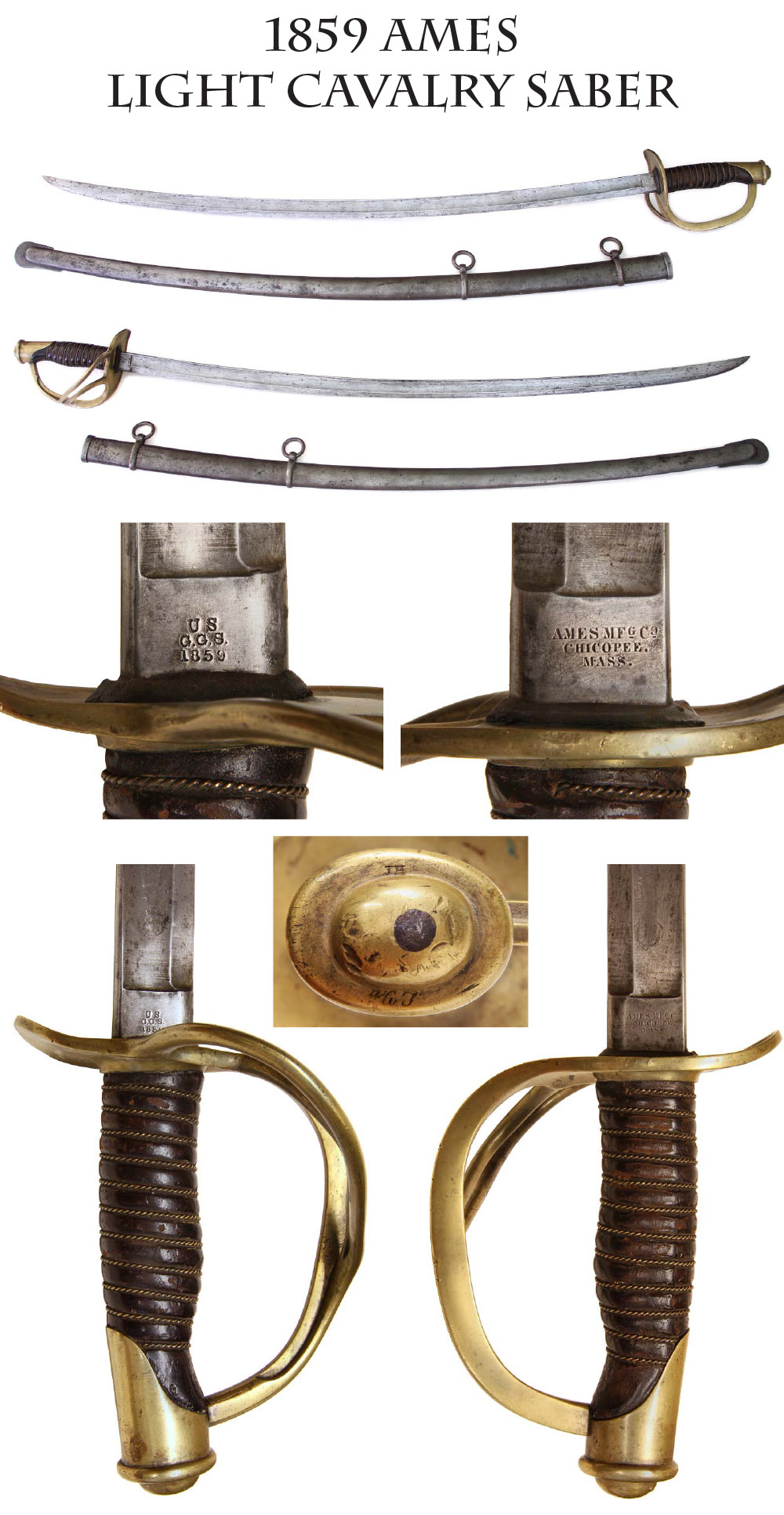
13-07-20 … Extremely Rare 1859 Dated Ames Light Cavalry Saber:
Finding these light cav’ (aka Model 1860) sabers dated this early is a very rare event. This one is very nice overall. …dated 1859 with full Ames firm markings and US inspectors’ marks. Complete with scabbard. Grip leather and twisted wire are about fine plus, showing only light handling wear… Scabbard is free from dents and overall grey steel. Blade likewise very nice grey steel with two small edge nicks. Very solid. Very scarce
… $1,450.00 SOLD
Click Here to E-mail Us!
Call us @ 419-842-1863

13-07-21 … Model 1840 Dragoon Saber by Sheble & Fisher:
Scarce pre war saber made in Philadelphia. Overall VG condition with restored grip leather and wire. Blade is excellent with much luster. Scabbard is VG and gun metal grey steel. Brass guard shows rack number and a star marking I am unfamiliar with. Top notch wristbreaker
… $850.00 SOLD
Click Here to E-mail Us!
Call us @ 419-842-1863
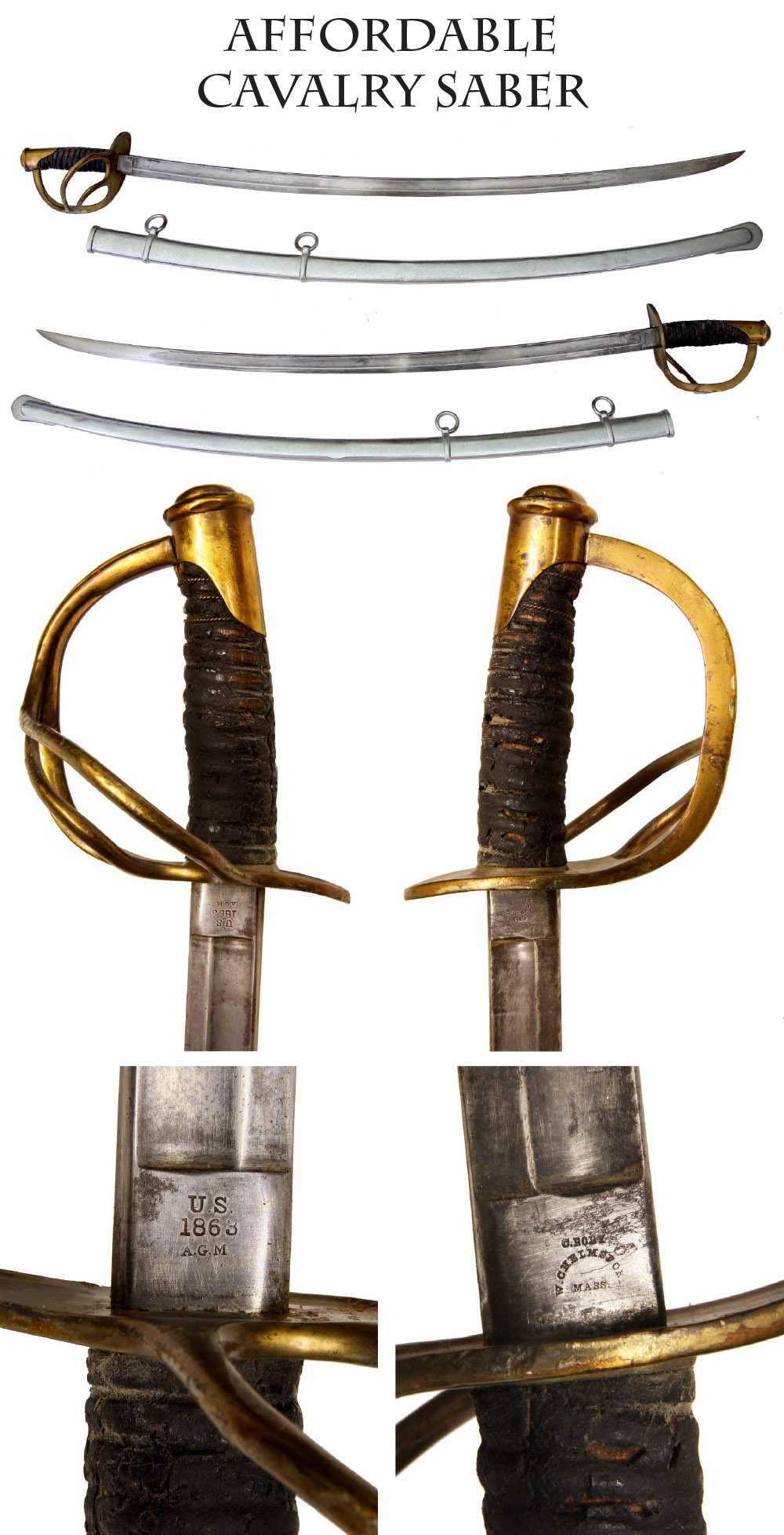
13-07-22 … Affordable 1863 Dated Saber:
A solid Christopher Roby marked light cavalry saber with desirable date of 1863. Condition is about good with nice blade, worn grip, and cleaned scabbard. Grip is very worn with areas of leather missing and it is lacking the twisted wire. Scabbard is over cleaned to bright and may even have a coating of silver paint. A solid real Civil War saber with scarce mid war date priced CHEAP …
$395.00 SOLD
Click Here to E-mail Us!
Call us @ 419-842-1863
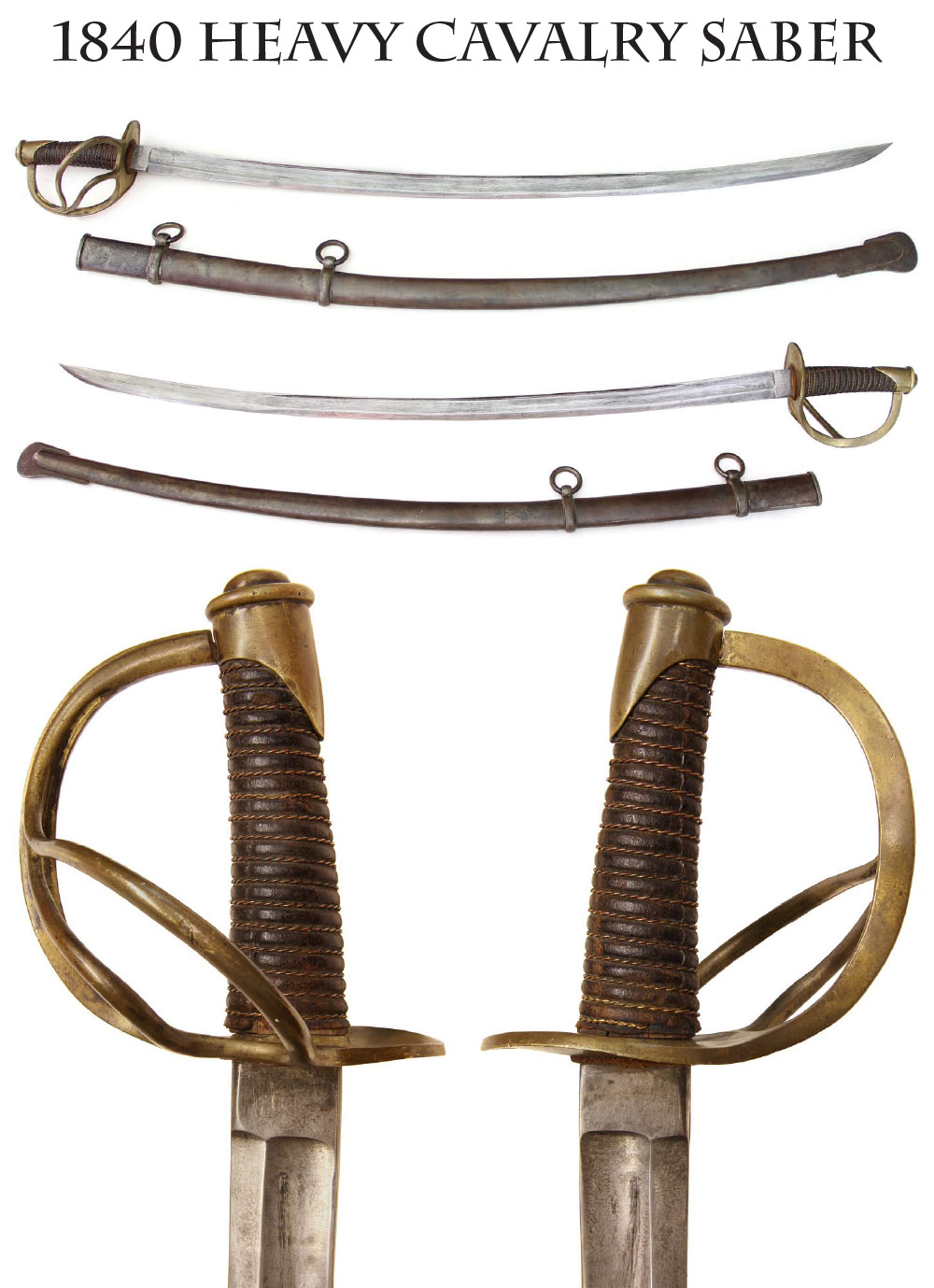
13-07-23 … Super Import Heavy Cavalry Saber:
Classic unmarked heavy dragoon saber as imported by the tens of thousands by both US and CSA buyers in 1861 and 1862. Overall VG++ condition with super grip, full wire, good blade, great scabbard etc … A very fair deal at
… $575.00 SOLD
Click Here to E-mail Us!
Call us @ 419-842-1863
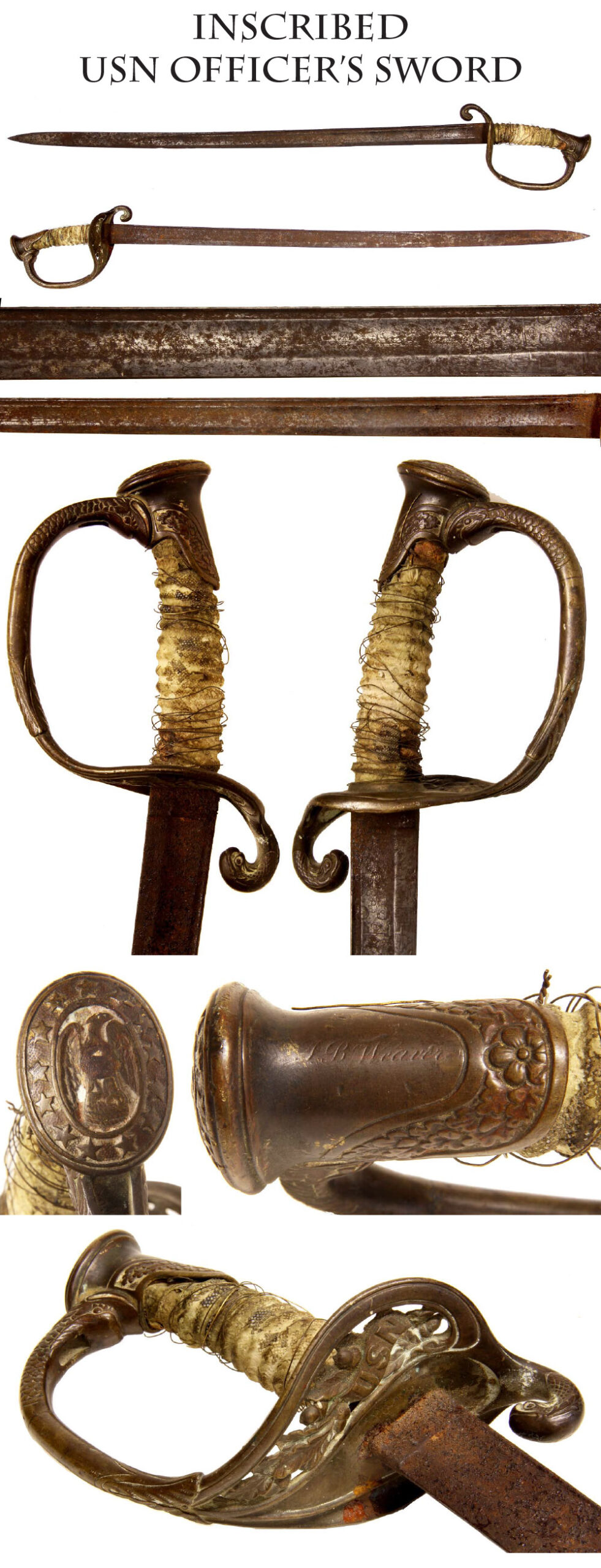
13-07-24 … Relic Identified US Navy Officers Sword:
The pictures tell the story … a basement or garage relic CW Navy sword. Best part is officers name engraved on the pommel. He served in USN for 1864 and 1865! A real inscribed USN sword for only
… $475.00 SOLD
Click Here to E-mail Us!
Call us @ 419-842-1863
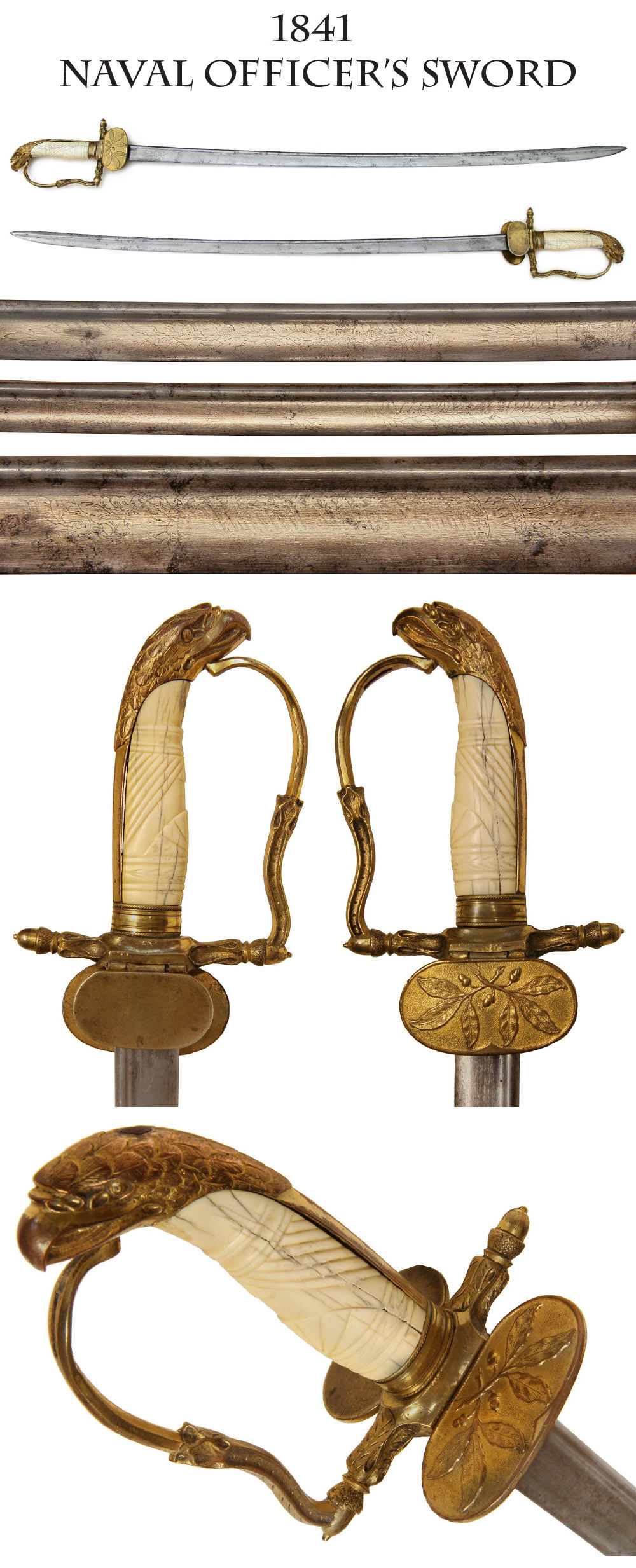
13-07-25 – Extremely Scarce US model 1841 regulation naval officers sword:
This style has a folding guard and a folding counter guard. It has an engraved quill back blade engraved “United States Navy” with numerous other military etchings. Etchings are visible and show wear. I find no makers marks on this but the quality is top end. Just lacks the scabbard. Scarce sword
$1,250.00 SOLD
Click Here to E-mail Us!
Call us @ 419-842-1863

13-07-26 … 13-01-12 – Quarter Plate Tintype: As if he were on the company street!
Quarter plate tintype, uncased, but with mat, frame and glass, of a Civil War Union officer posed in front of a painted backdrop showing a line of tents running back from the right with a stack of muskets in the background. Three-quarter length, knees-up, standing view, one hand at side, the other apparently part way in his pocket. Turned slightly to the viewers right to help with the illusion of the backdrop that he is standing in a camp rather than a photographers studio, and rather like he has paused while walking across the campground. He wears a tall forage cap typical of private purchase headgear and a brass-buttoned military vest showing a watchchain beneath an opened sack coat with dark collar and no buttons or insignia visible. Nice wide elbow and a breast pocket on the coat. Possibly a well-heeled enlistedman, but very typical of an officer in undress uniform as worn around camp, etc. Sharp focus on face and hand at his side. The camera even captures the texture of the coat: what looks like a velvet collar and a heavy weave to the body, suggesting a fall or winter visit to the photographer. Handsome fellow with a penetrating gaze directly into the camera lens. Scattered freckling to the emulsion overall with some scratches and rubs. One small rust speck to right of subject and line of corrosion at the bottom hem of his coat, but a nice sized shot of a Civil War officer posed in an interesting fashion by the photographer. A great Civil War portrait with lots of jazz
… $150.00 SOLD
Click Here to E-mail Us!
Call us @ 419-842-1863

13-07-27 … 13-01-19 – Original Buff Leather Saber Hanger Straps for Cavalry Saber Belt:
Here is something that NEVER turns up, both the long and the short saber hanger straps for the enlisted cavalry saber belt. These buff leather straps came to me hanging on the scabbard of a fine condition cavalry saber. I was astounded that they were present and removed them from the scabbard rings PDQ. We frequently find the buff belts with eagle buckles missing the saber hanger straps. Well here is your opportunity to buy the original straps to restore your belt. Excellent condition. The straps are buttoned together in the photo illustrations shown here. Still pliable good color no damage
$495.00 SOLD
Click Here to E-mail Us!
Call us @ 419-842-1863
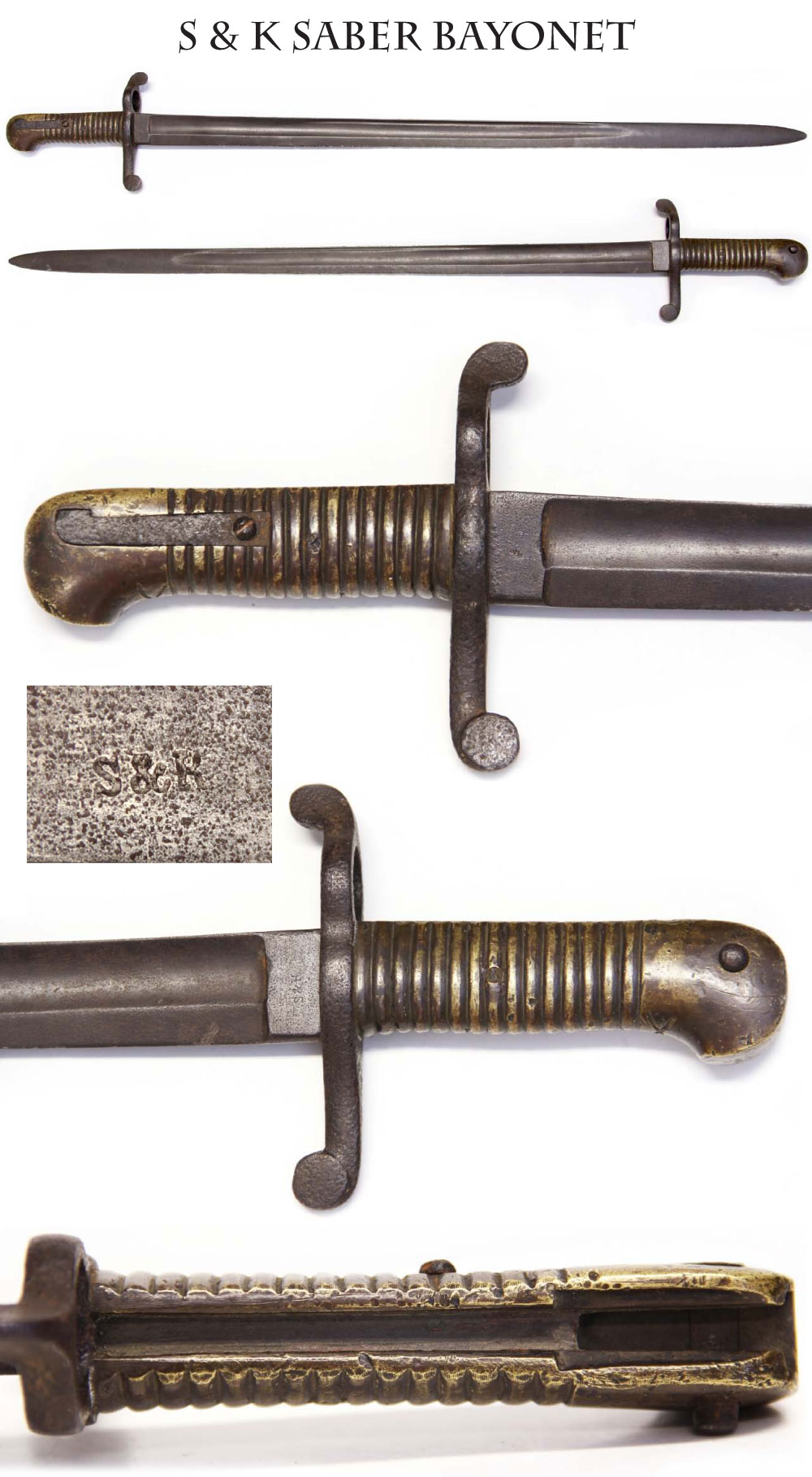
13-07-28 … 13-01-21 – Saber Bayonet for Colt Revolving Rifle:
Actually this is the S&K (Schnitzler & Kirschbaum Solingen) saber bayonet which fits a number of Civil War era rifles. But its claim to fame is that it usually fits the military style Colt revolving rifle. Overall VG condition.
$195.00
Click Here to E-mail Us!
Call us @ 419-842-1863
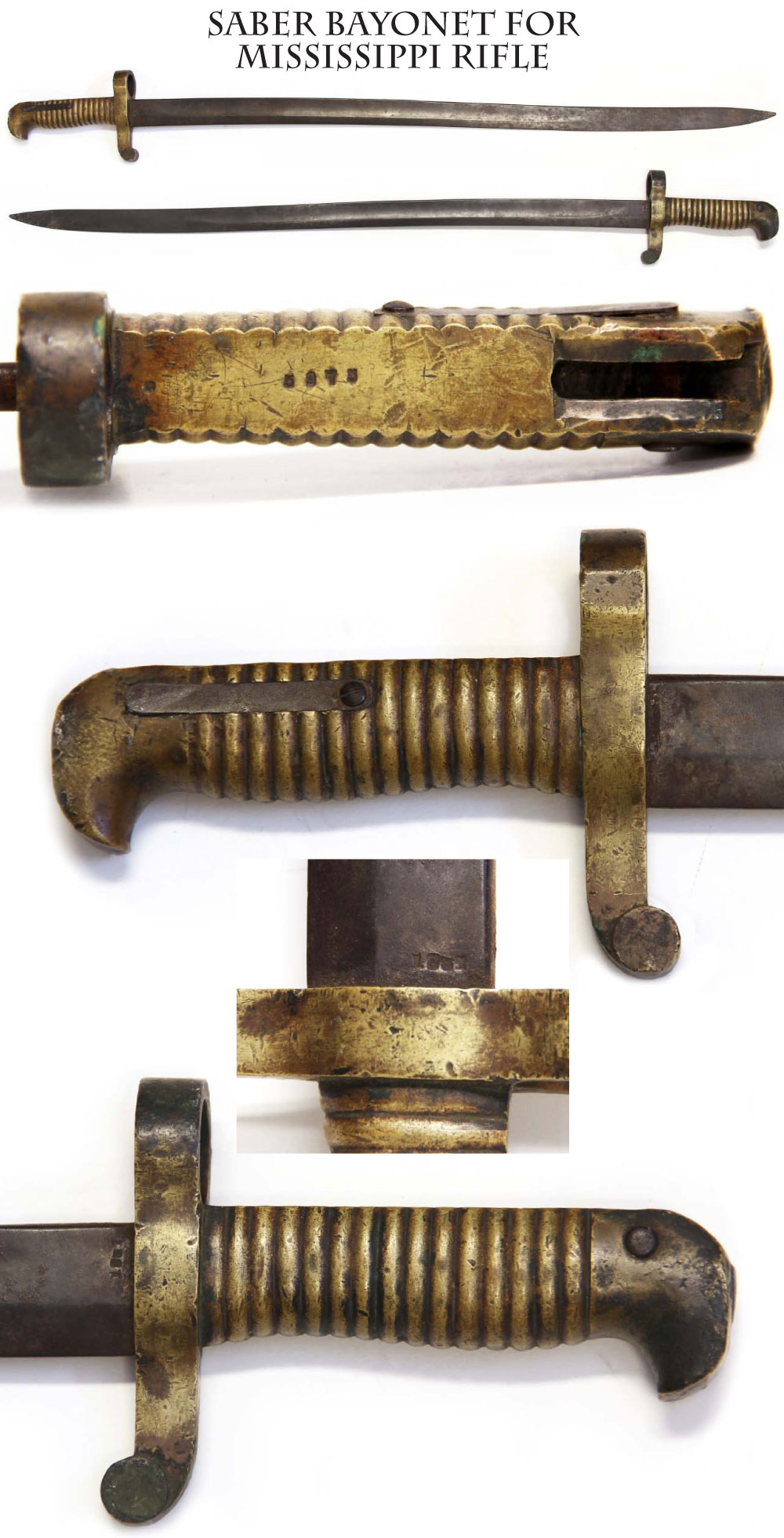
13-07-29 … 13-01-22 – Saber Bayonet for Colt Alteration of Mississippi Rifle:
A very good to fine example of the brass handle saber bayonet for the M1841 US Rifle aka Mississippi Rifle with the Colt factory alteration of adding rear sights and bayonet lugs. Good solid example
$325.00
Click Here to E-mail Us!
Call us @ 419-842-1863

13-07-30 … 12-12-15 – CDV Mid-chest-up view of a young mustached soldier.
Albumen portrait trimmed to an oval and fixed on a CDV card with a pre-printed frame to surround it. Corners slightly rounded for album insertion. Ewing & Co. Cumberland, MD, photographer backmark and tax stamp. Our boy wears a somewhat high-collared military jacket with six brass uniform buttons showing. No further identification seems possible, but he is a nice representative of the thousands who went off to defend the Union and this is a good example of the carte-de-visite format of photography that used a negative to print multiple positive images for a customer.
$29.00
13-07-31 … 12-12-16 – CDV Researchable Regular Army or New Jersey.
Another friendly-priced Civil War carte-de-visite. Vignetted waist-up view of a young man wearing a sack coat turned back to show a military vest. Signed in ink across the front: Truly Yours, / E. V. H. Bowe or E.O.H. Bowe or Boon or Bone or Bo??? / U.S.A. S. Stokes, Trenton, NJ photographer backmark and tax stamp. Card trimmed at top and corners rounded for placing in an album. In the Civil War USA was the customary abbreviation for US Army, meaning the regular army versus the volunteer forces raised by the states. If you have some time on your hands you will undoubtedly be able to uncover this mans identity. I simply dont have the time to spend researching all the possible names that might match his stylized autograph. A fun project for you
$35.00 SOLD
Click Here to E-mail Us!
Call us @ 419-842-1863
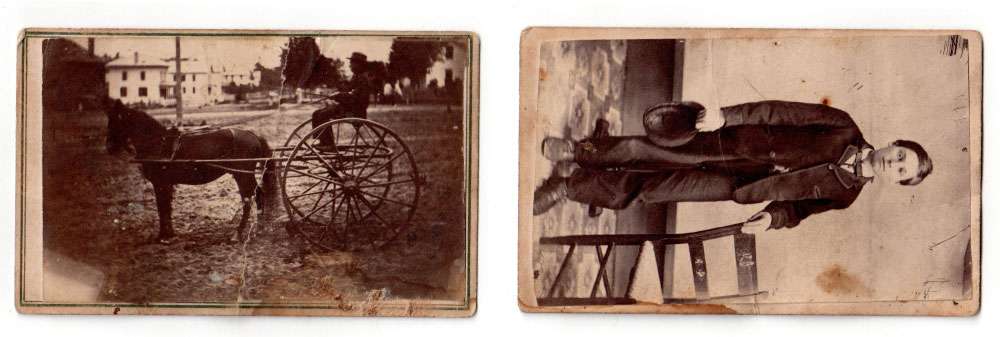
13-07-32 … 12-12-17 – Harness Racing 1860s Style.
Nice horizontal outdoor cdv view of a proud horse owner seated on a two-wheel sulky showing off his favorite racer. The reverse has the image of a young man on it, so we cant tell the location by a backmark, but several large houses are visible in the background. Immediately behind him is either a street or part of race track. There is a vertical crease in the center of the carte, and some dirt along the bottom edge. Another of those outdoor views I like that let you step back in time to mid-nineteenth century America.
$45.00
Click Here to E-mail Us!
Call us @ 419-842-1863
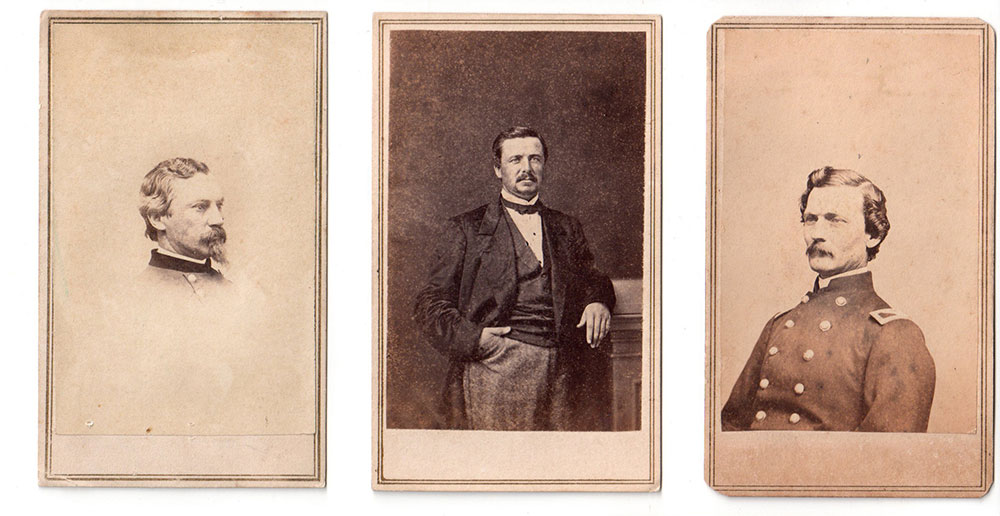
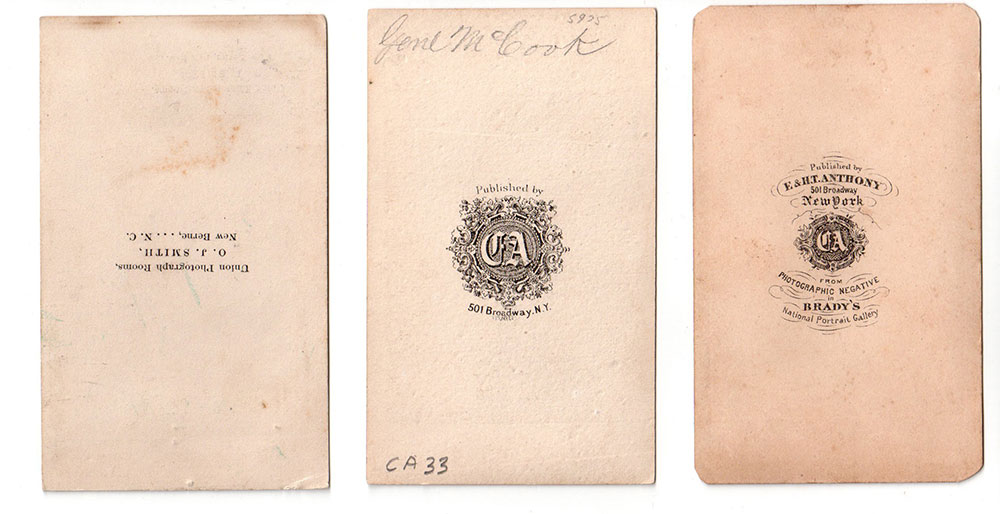
13-07-33 … 12-12-18 – CDV Mystery General In New Bern NC:
Dashing looking gent wearing a Union Army Generals frock coat. Top two buttons visible as is velvet collar. I do not recognize this man but the back mark shows he had this picture taken in New Bern NC. That should aid you in your research to uncover his identity. Obscure generals are among the most collectible of Civil War CDV photos
… $165.00 SOLD
13-07-34 … 12-12-19 – CDV General Alexander McDowell McCook:
One of the fourteen Fighting McCooks, well known members of a large family devoted to the Union. 2/3 standing view in civilian clothes, Anthony backmark. West Point class of 1852, served on the frontier and at the USMA. Colonel of the 1st Ohio at Bull Run, brigadier general in September, 1861, and major general in July, 1862, commanding a brigade in Kentucky and a division in the Army of the Ohio at Nashville, Shiloh, and Corinth. Commanded the 20th Corps at Perryville, Murfreesboro, Tullahoma, and Chickamauga. He was given brevets of brigadier and major general at the end of the war and made lieutenant colonel of the 26th US Infantry. He remained in the army after the war, serving on the frontier and on Shermans staff, eventually making colonel, brigadier and then major-general, at which rank he retired in 1895
… $79.00
13-07-35 … 12-12-20 – CDV Photo Col James Fry:
He defended Buell at Shiloh. Served as Colonel, Brigadier, and Major General. Nice waist-up seated view, Brady/Anthony backmark showing him in his Colonels uniform. Born in Illinois in 1827, Fry was West Point class of 1847 and served in Mexico before being detailed as Adjutant of the USMA from 1854 to 1859. Briefly commanding an artillery battery at the beginning of the war, he was commissioned into the Adjutant Generals Department and acted as chief of staff for both McDowell and Buell. He was one of the champions of Buells role in the Battle of Shiloh which Grant and Sherman were very interested in playing down since they did not want to seem rescued by Buells timely arrival. Nevertheless, upon creation of the Provost Marshals Department Fry was recommended by Grant and made Provost Marshal General. Fry enlisted and was commissioned on 3/16/1861 as Captain and Asst. Adj. Gen. in the US Army Adjutant Genl Dept . Discharged for promotion on 11/14/1861, he was commissioned into US Army as Colonel and Asst. Aide-De-Camp and then discharged again for commission and promotion on 3/17/1863 into the US Army Provost Marshal Dept (Colonel and Provost Marshal General,) and on 4/21/1864 for commission into US Army General Staff as Brig. Gen. At the end of the war in March, 1865, he received regular army brevets as Colonel, Brig.-General, and Major General. Fry served in the army until 1881, but continued writing on military subjects after retirement and died in 1894 in Rhode Island.
A fine view of a very scarce subject.
… $225.00
Click Here to E-mail Us!
Call us @ 419-842-1863


13-07-36 … 12-11-09 – Soldier’s Money Belt, Housewife, Coin, and Relics with Family Tags:
A wonderful lot of soldier personal items with intriguing hand written family notes. When I bought this all the items were mounted in a wall frame assembled in the mid 20th century mounted on non archival paper backing. I removed it from that inappropriate container. The grandchildren of the veteran wrote the notes stating that Grandpa Hiram Burlingame had been from Pennsylvania. The research I have done indicates that Hiram Burlingame was actually from Massachusetts. I find Hiram in the 46th Mass. with additional service in the 27th Mass. There are no other soldiers with that name shown on either the National Park Service web site nor the civil-war-data site. He is shown as Hiram J.R. Burlingame Jr. of Holyoke, Mass. — wounded in action at Cold Harbor. The housewife (sewing kit) is really great. Measures about a foot long when unrolled and obviously made by hand by a woman on the home front. The money belt is a high quality affair of fine red leather lined in a fine cotton or muslin. The inside has compartments for money and other valuables. The coin is an 1853 copper cent. The square nails were interesting to the family but not so much to me, and the little lead soldier likewise.
A very honest and appealing lot of soldier items
… $395.00 SOLD
Click Here to E-mail Us!
Call us @ 419-842-1863
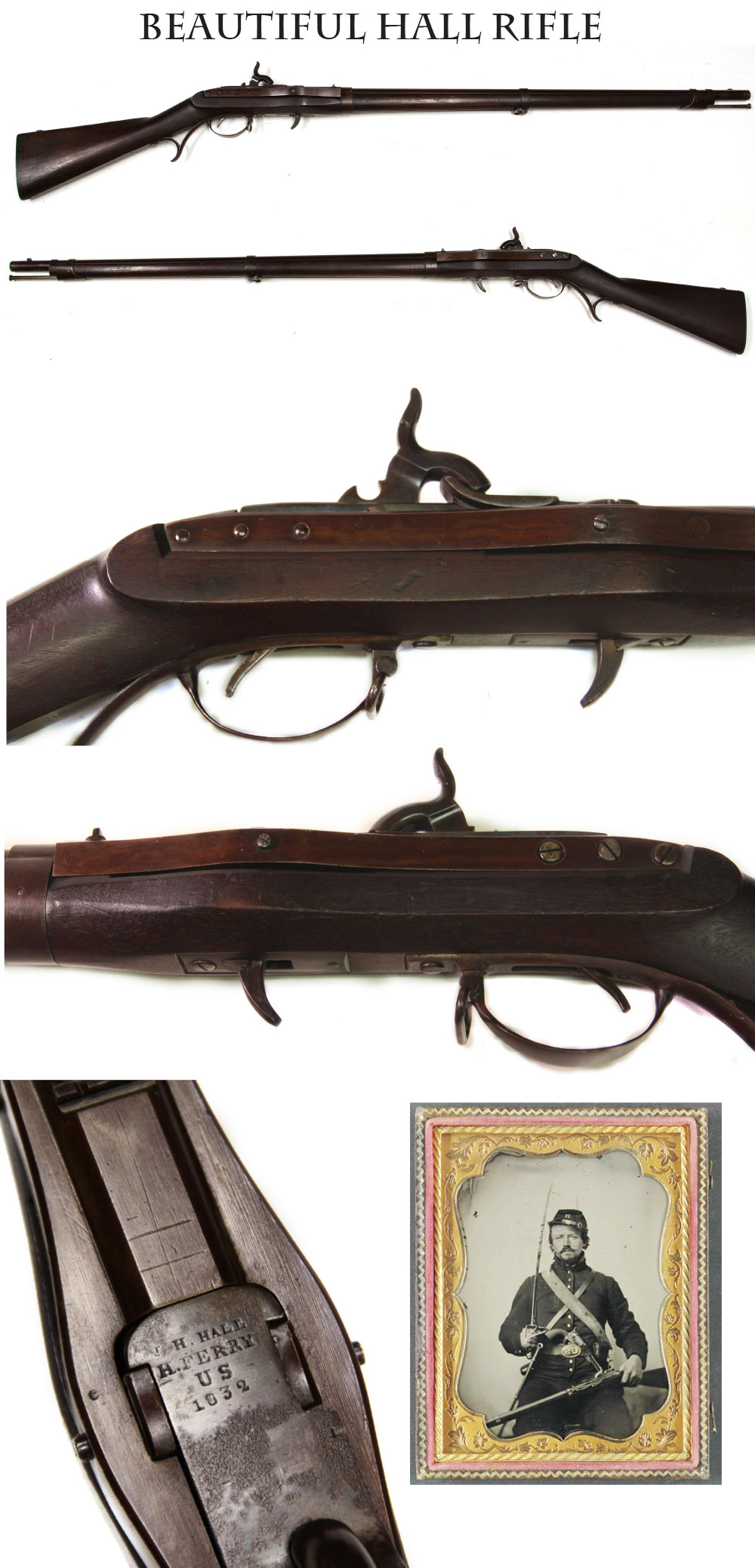
13-07-37 … 12-10-19 – Investment Grade Model 1819 Hall Rifle
Converted to Percussion in NRA “Excellent” Condition: Extremely fine condition retaining 95% original lacquer brown finish on the barrel and frame, and having “minty” stock with very sharp edges and showing only minimal handling wear. Slight wear on the finish near the muzzle. A top notch example in anyone’s book. The breech block is stamped “J.H. Hall / H. Ferry / U.S. / 1832” showing this to be part of the second production run of these interesting breech loading rifles. 52 caliber with an excellent bore.
You would be hard pressed to find a better example
… $2,995.00 SOLD
Click Here to E-mail Us!
Call us @ 419-842-1863
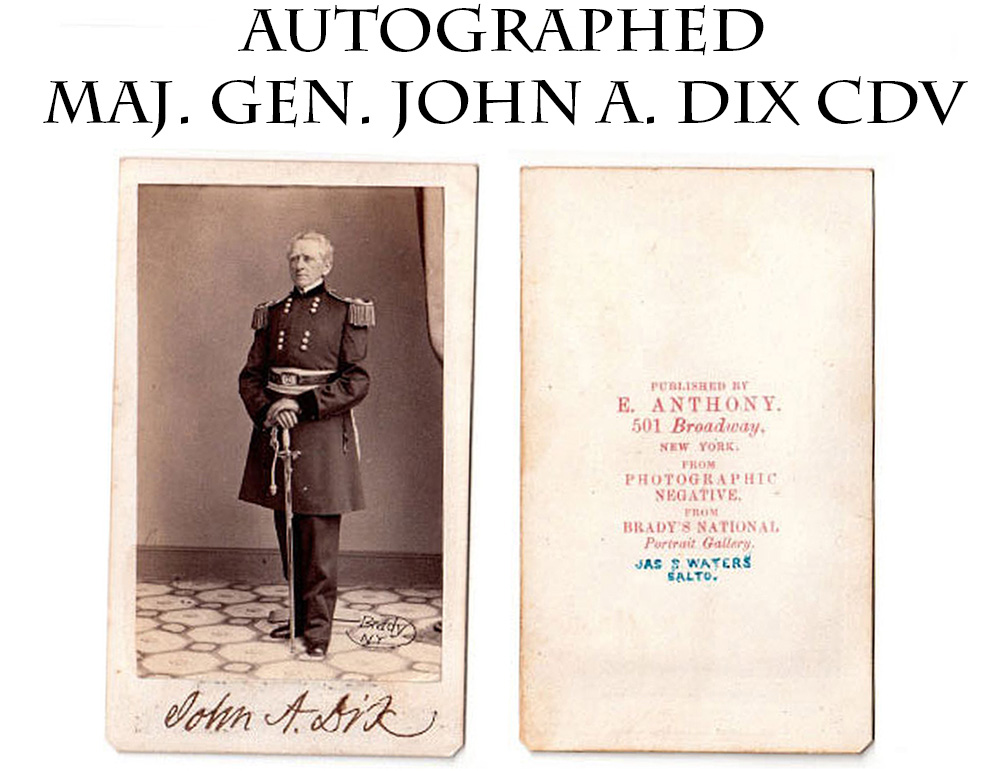
13-07-38 … 12-10-25 – Fine and Scarce Autographed CDV of Maj. Gen. John A. Dix.
His most famous quote … “If anyone attempts to haul down the American flag, shoot him on the spot.” There is even a Civil War penny token which utilizes this wonderful quote. Very sharp full-standing Matthew Brady view with Brady’s name in the negative at bottom right (the better to deter pirate copies!) Signed boldly in his own hand… “John A. Dix” in ink prominently at bottom center. Dix is shown with his hands folded on a beautiful 1832 General Officer’s sword with a knot, swordbelt with NY officer plate, and a major general’s frockcoat with epaulets. Dix had served in the War of 1812, but left the army in 1828 and settled in New York. He served briefly in the US Senate and after the war a term as Governor of the state. In 1861 Lincoln made him Major General of Volunteers 5/16/61 and that early date meant he outranked all other volunteer officers. As Secretary of the Treasury under Buchanan as the Civil War approached he sent his famous message to a Treasury official in New Orleans: “If anyone attempts to haul down the American flag, shoot him on the spot.” Dix’s signature is very strong at the bottom center of the carte … A very collectible CW autograph and
even more desirable being autographed on the front of the photo
… $395.00
Click Here to E-mail Us!
Call us @ 419-842-1863

13-07-39 … 13-06-04 … Exceptional Freshly Found Flintlock – Untouched and Attic Dry Early Production 1817 Common Rifle
… likely by R. Johnson with Original Bayonet! I personally pulled this out of a home in southern Michigan where it had been stored forever. Never touched by collector hands. Never oiled. Never messed with. I love these guns that come to us untouched by modern hands. This gun sat unappreciated and ignored … mutely passing decade after decade, existing in storage unmolested through most of the nations history. It passed through wars and elections, existing through 40 of our 44 Presidents, season after season after season passing, and generations of owners sometimes looking at, but likely not knowing nor caring about the story behind the old family gun stuck in the closet, or corner of the attic. Such heirlooms are a rare find in these modern times. This is the 1817 US Contract Rifle, also known as the Common Rifle. It has the untouched attic condition we dream of finding at a farmhouse tag sale. These are elegant guns, iron mounted, finished bright in early production, browned in later, rifled .54 caliber barrels, oval patchbox, brass flash pan and a sweeping lower triggerguard bow that supports the lower sling swivel. These were produced only by a few contractors for the government. They were surprisingly popular, many being converted to percussion and still in service at the beginning of the Civil War. This specimen was never converted. It is still the original flintlock version just the way it was produced nearly 200 years ago. This has an even smooth brown tone overall, deep age patina on the brass pan. Thin crustiness near the breech, loads of untouched crust on the touch-hole, dappled corrosion on the lock mostly forward of the hammer. The gun is sharp showing careful handling and use. The age it exhibits is storage age (rust, dust, and dirt) no abuse or damage. Barrel and lock marks clearly legible, tight wood to metal fit. Stock shows very few handling dings, sharp original edges, and clear ink inspectors cartouche on the left stock flat opposite the lock. The lockplate is stamped deeply with a US forward of the hammer and I see no other marks below it. Robert Johnson is known to have used only a US mark on some of his 1814 contract rifles and I am confident that this is exactly that One of his leftover 1814 locks which he used on his contract with the government for the Common Rifle. The earlier 1814 rifles are very similar in appearance to these common rifles but have different barrel lengths, flash pans, trigger guards, and they carry a bayonet stud. Our gun here has the 1814 style lock with flash pan which slopes forward in the lock, and it also carries a bayonet stud. Both features are a carryover from the Model 1814 and not something seen on most Model 1817s. Johnson had one of the early 1817 contracts in 1821 (preceded only by Deringer,) and was already set up for production from his 1814 contracts. Indeed, he got 260 of his 1817s delivered by the end of 1821. My feeling is that this is likely one of those first rifles. An additional element pointing to an early production date is the presence of the bayonet lug- this was a carry-over from the 1814s, but not specified for the 1817s. In addition – this gun still has the original rifle bayonet on it! A beautiful even plum patina overall, with a small makers stamp near base of the blade. Bayonet Stats: 17.5 overall, 2.75 socket length, 14.5 blade length, .855 inner socket diameter at muzzle. No blood groove in the face of the blade. Has tiny 3/32 square punch stamp dead center in the middle of the ricasso. No other marks. I would wager that this is one heck of a rare bayonet– on the loose this would probably be the subject of long debate among bayonet collectors and be misattributed in the end. It looks like a Model 1816 bayonet but the interior socket diameter is slightly larger. It fits perfectly on the Common Rifle and is sloppy on an 1816 musket. We tend to take rifles for granted as modern arms, but they were a specialized weapon in the early nineteenth century military and they are a very interesting category of US martial arms collecting. You wont get many chances at an uncommon and untouched piece like this. I was ecstatic when I found it and it deserves a good collection for its next home.
It is one of my favorite finds of recent years
… $4,850.00
Click Here to E-mail Us!
Call us @ 419-842-1863
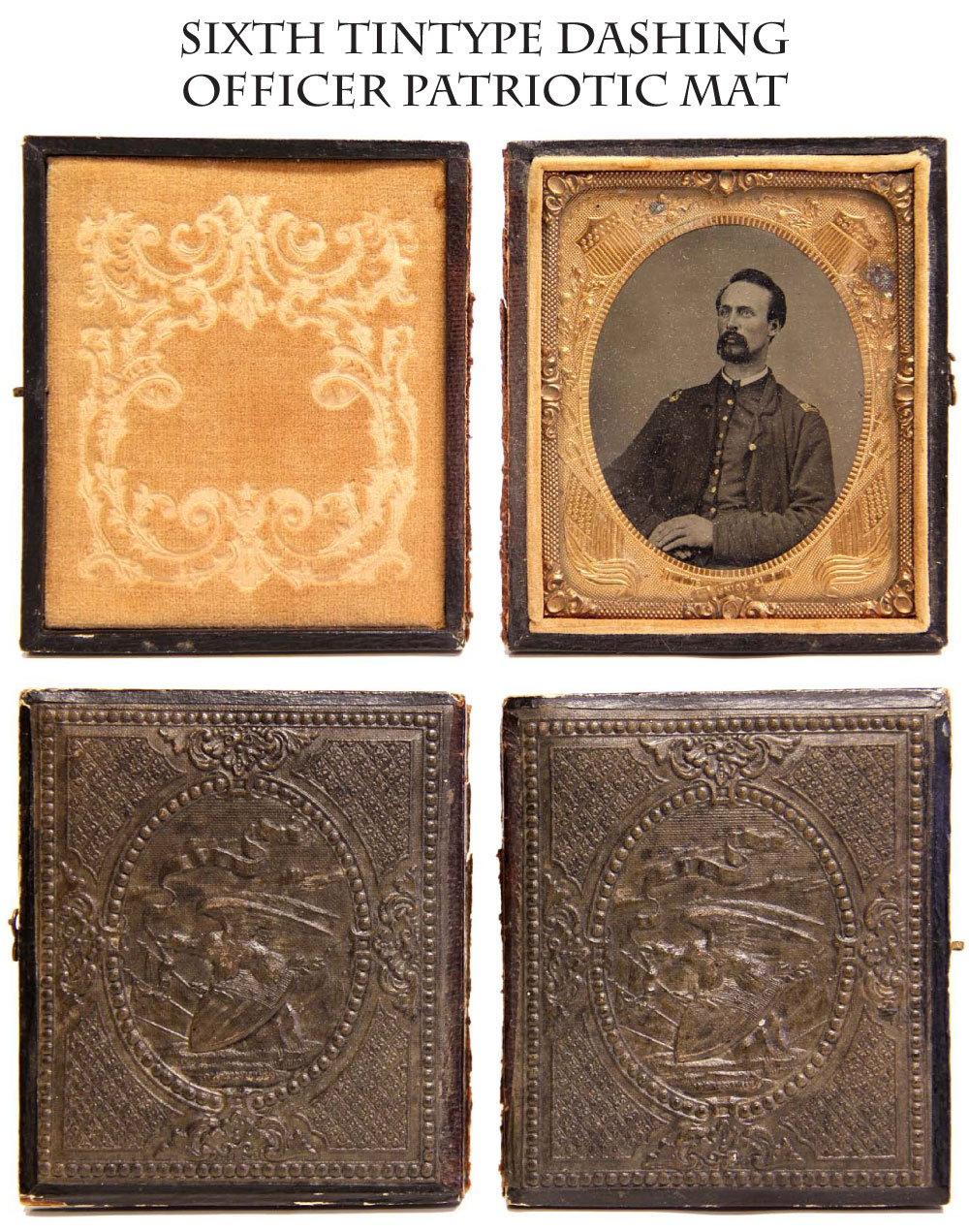
13-07-40 … 13-06-08 … 13-03-14 – Patriotic leatherette case and mat housing a noble looking line officer:
The case is separated at the hinge, but bears a wonderful eagle perched on a shield and trophy of arms with a ribband waving above it, embossed on both front and back in an oval on a geometric ground. The inside of the case adds to the motif with a patriotic mat embossed with flags at the bottom and US shields at the top. Our subject is a Union line officer, half length, seated with his hands folded, fatigue coat open to show his dark colored vest, leaning back slightly and gazing up and off to the viewers left with a kind of detached, noble gaze. The folks at home must have loved it. Very appealing image.
$145.00
Click Here to E-mail Us!
Call us @ 419-842-1863

13-07-41 … 13-06-10 – 1843 Dated Pomeroy 1835/40 Pattern Conversion Musket with Correct Civil War Bayonet and Scabbard.
Arsenal type cone-in-barrel “Belgian” conversion of an 1840 contract musket. These late production flint muskets went pretty much direct from the contractors to the arsenal racks for conversion and are the typical early war Civil War gun in the hands of the volunteers. This one even retains its bayonet and Civil War scabbard (priced separately). Very good lockplate marks: L. Pomeroy under eagle forward of hammer, 1843 / U.S. to rear. Sharp matching barrel date and US/NWP/P proofs. Very good edges to wood. Crisp cartouches. Metal in the bright, now toning down. Very minor firing corrosion near the nipple. The eagle on the lock a tad rubbed but very visible. Bayonet a nice even brown patina on the socket and bit brighter on the blade where it was kept sheltered by the scabbard. About a 2 inch section of the scabbard seam open, but the scabbard fairly solid. The bayonet was with this gun when I got it, but I will price it with and without the bayonet.
Musket without bayonet
… $1,450.00
Musket with Bayonet
… $1,650.00 SOLD
Click Here to E-mail Us!
Call us @ 419-842-1863
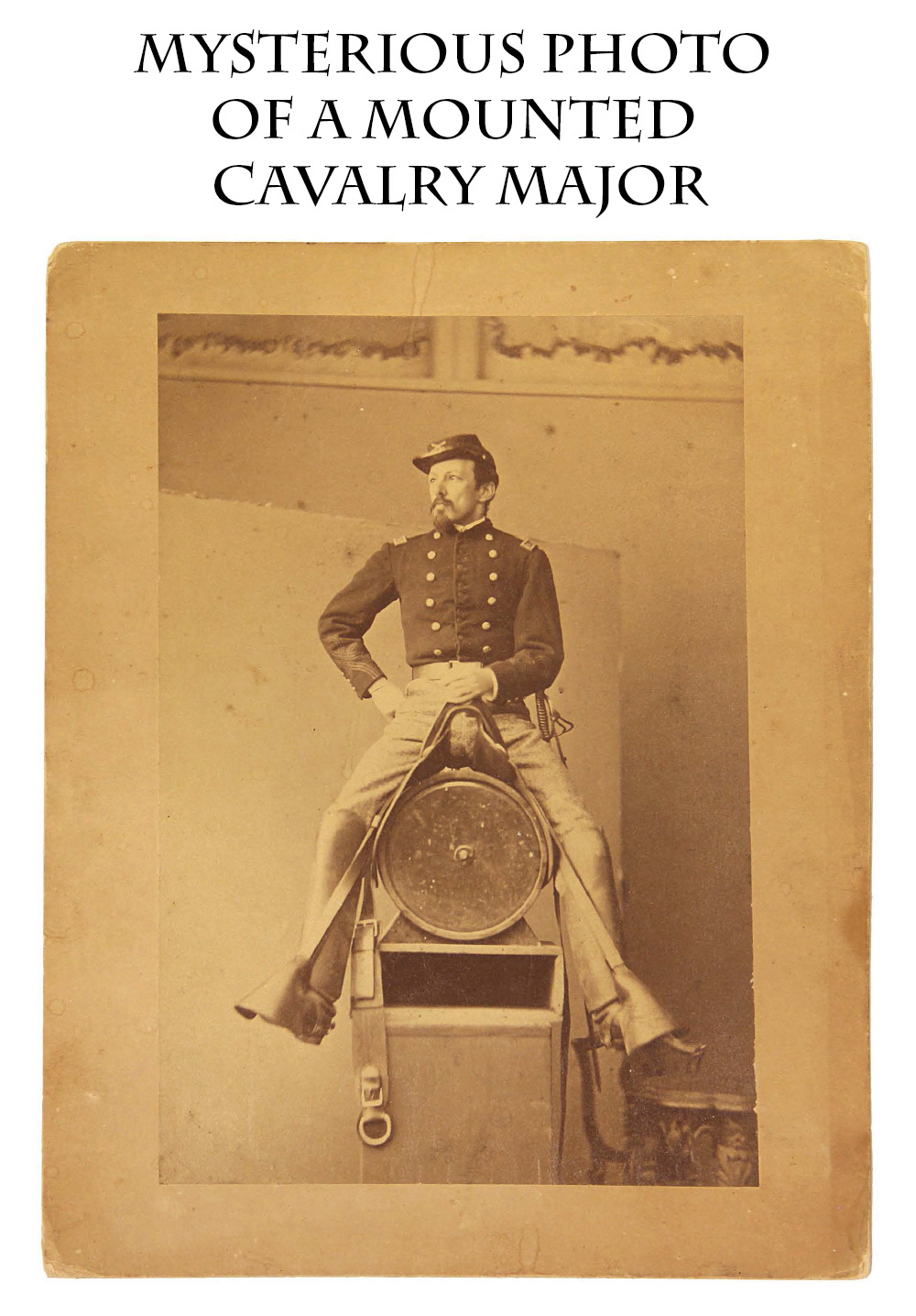
13-07-42 … 13-06-15 … Mysterious Cavalry Photo – Mounted Cavalry Major:
This image is one of the most unusual I have owned, and has been the subject of many a debate here in the shop. It is a striking and wonderful photo of a US cavalry major handsomely posed seated in his saddle, one hand on his hip, the other on the pommel of his saddle, gazing off to the viewer’s left, wearing his officer’s cap with crossed sabers visible, an officer’s shell jacket with two rows of brass buttons, shoulder straps that appear to have oak leaves at the ends, major’s braid on his cuffs, with saber belt at his waist and his saber with sword knot at his hip. The obvious mystery of course, is why the saddle is strapped to a barrel or keg, resting on a stand in a photographer’s studio.??? The plain backdrop shows behind him, as does the upper part of the studio wall, and below and to the right his spurred boot in stirrup hovers inches above a table. In terms of the “professional” debates here in the shop … One of the I-T guys thinks the officer is comic relief. He came up with our title –
“Hypnotized Officer Surveys Imaginary Battlefield on Make Believe Horse.”
I like that “take” on the image and will allow that such a pose is unique in my experience … making this the rarest Civil War photo of all time. Another of our experts thinks it might be some sort of set up for riding instruction or cavalry training. The chief outside research expert (the smart one in the bunch) thinks it may be an artist’s study photo created for a painter doing a painting of this officer. His evidence??? … A photo published in Military Images magazine of a soldier seated backwards on top of a chair, which is believed to be an artist’s study for a painting of a sentry seated on a rock. In any case, this is a riveting image. I notice the officer’s jacket actually has a single row of dark buttons in the middle of the other two rows. We are possibly looking at a captain recently promoted or breveted to Major who modified his old jacket. I see no sign of a tax stamp on the reverse, and I cannot determine if this is Civil War or early Pre Custer Massacre.
My gut feeling is that it is circa 1866. This too would tend to support the theory that the photo is a Civil War officer posing for a portrait celebrating his wartime career. If one of you has an oil painting of this mounted hero in your collection let us know.
A very cool image in any event. Mount measures 8 by 10, and the image proper 8.25 by 5.5.
This would look great with some cavalry gear and certainly have the visitors talking
… $450.00
Click Here to E-mail Us!
Call us @ 419-842-1863

13-07-43 … 13-06-16 … Wonderful Rare and High Quality Engraved L.A.C. Enfield Rifle Musket ca. 1861:
A true prize an Extra Fine Engraved example of the P-53 Enfield made by the London Armory Company and sold by E.M. Reilly and Company. Standard military configuration 1853 pattern Enfield signed on the lock E.M. Reilly & Co., New Oxford St., London. Reilly is well known maker and dealer of quality shotguns as well as military arms. He began operations circa 1861 and this musket would date to that time period. Lock also bears a Crown/ V.R. at the rear. Barrel has sharp 25 Bore touch mark (.577 Cal.), inspection ciphers, and view and proof marks on left barrel breech. NRA fine to excellent condition. 100% original, 100% complete, and mechanically perfect. Rod, swivels, sights, etc everything original and in place … All the brass parts are beautifully engraved. The elaborately engraved trigger guard tang has scrolls, floral motifs, and a panoply of arms on the bow. It bears an engraved serial number on the trigger guard tang, and matching scroll floral engraving on the nose cap and butt plate tang! My initial research on this gun revealed that Reilly had some of his guns engraved by the man working next door to his gun factory. I seem to recall that the engraver was his brother in law, or brother … Ill let you finish the research. Condition is stellar … Tight fit wood and metal, sharp edges on the wood around the lock and to the flat opposite. There is a crack in the toe of the butt stock caused when the gun was dropped on its butt, which sheared off a chunk of wood. The original wood was re-glued in place leaving a faintly visible line. Beautiful rich barrel blue about 97 percent, hinting toward plum on the bolster. Smoky faded case on the lock, the hammer showing a little more depth of color. Lock screws show faded bright, other screws have remnants of blue. Rod mixed dull silver and bluish gray. Bands match the barrel, mellow blue with hints of plum. Beautiful walnut stock, just a couple of minor handling dings. This is a magnificent percussion gun, created possibly for an infantry officer or NCO, or a presentation gift, or a prize gun for a marksmanship competition, or a sample gun showing the quality that was available ??? . The owner, whoever he may have been, was obviously proud of his rifle and took great care in maintaining it. This gun heads out of the narrow world of arms and into the larger world of art. I love being able to offer it, and you will love showing it off. A finer Enfield rifle musket you would be hard pressed to find …
$2,975.00 SOLD
Click Here to E-mail Us!
Call us @ 419-842-1863
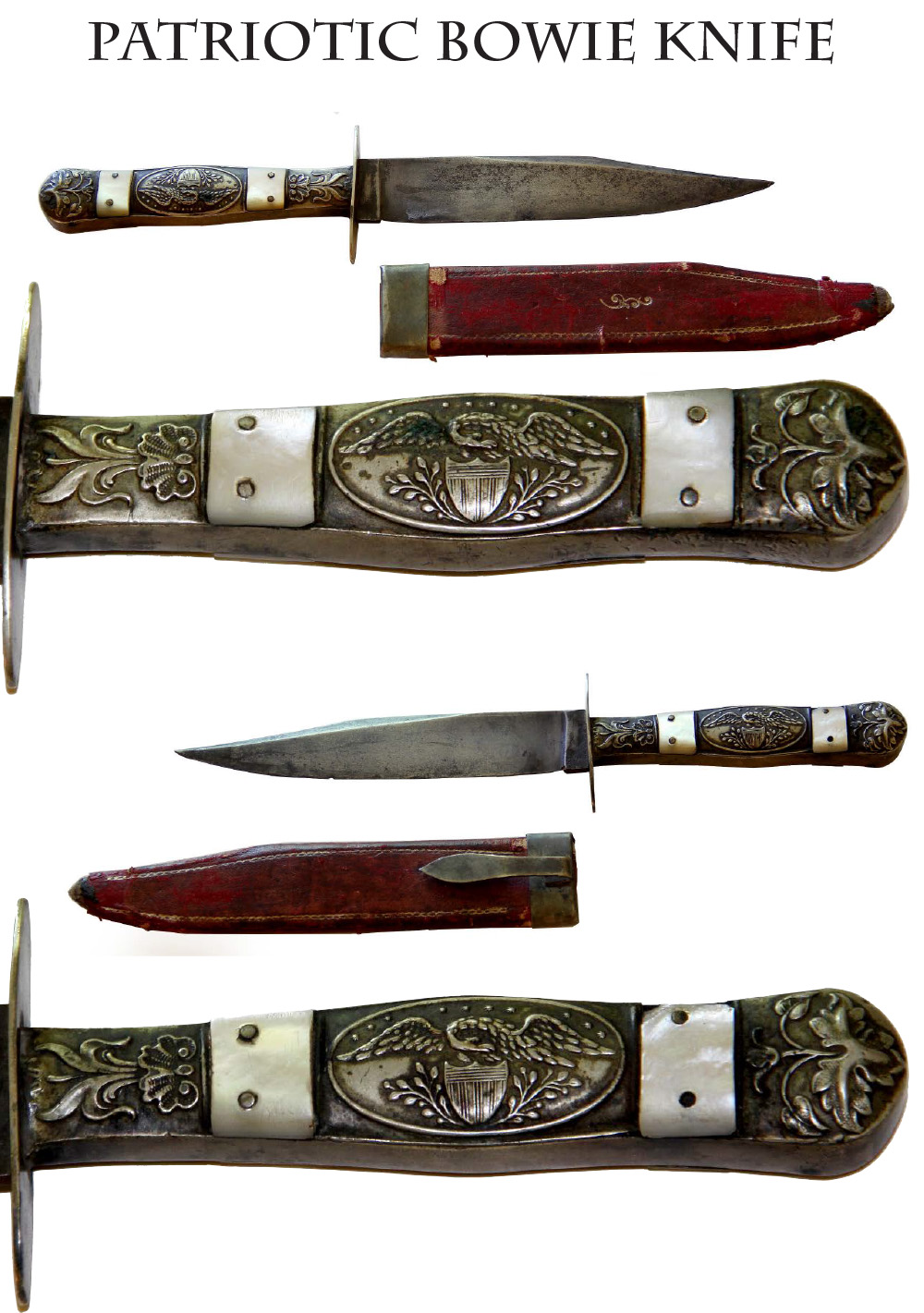
13-07-44 … 13-06-23 … Patriotic Bowie Knife with Original Red Scabbard.
Silver panel embossed grips with mother of pearl insets. The upper and lower sections are floral designs. The central panel on each side has a wonderful spread-winged US eagle curling its neck over a US shield with branches spreading below and a row of stars over the eagle. Nice untouched muted color to the silver. Oval German silver guard. Classic Bowie blade with false back edge. One minor nick on the edge, otherwise very nice. Untouched, uncleaned blade a dull silver also, with some graying and a smattering of dark spots. Unmarked ricasso. Original red leather or leatherette scabbard, with gilt embossed border decoration and a central flourish on one side. German silver throat in place with flat belt hook. Small metal tip is long gone, but the scabbard extends almost to the point. A very nice bowie of good form, excellent for an early western display or military display. The knife measures 10 3/4″ in length, with a 6″ blade. A classic Union Army soldiers knife
… $2,500.00
Click Here to E-mail Us!
Call us @ 419-842-1863

13-07-45 … 13-06-25 … A Holy Grail Uniform Jacket:
Ultra Rare Schuylkill Arsenal Artillery Buglers Jacket. These grid-iron front musicians jackets are about the flashiest piece of Civil War uniform cloth available, and for my money, the artillery version is even flashier than the cavalry. It is the regulation deep blue waist-length shell jacket with 12 button front and piping on the cuffs, two back seams, bolsters, bottom edge, and down the center front and up the collar edges and at the two false button holes at either side of the collar. Very attractive. Retains the full original white muslin body lining and sleeve linings. SA stamp in the right sleeve lining showing this was a product of the Schuylkill Arsenal at Philadelphia and a numeral 1 signifying a size 1. There is also a number 13 stamped in the left sleeve, which is likely the number assigned to the individual seamstress who sewed this jacket. The Schuylkill Arsenal pieced out the sewing work to local women which helped support the widows and dependents of soldiers. There is one small hole in the lining of the upper right shoulder, otherwise about perfect save for some color run on the red trim on the cuff. Overall excellent condition. These coats were US Army regulation for the two buglers assigned to each battery of both field and horse artillery to communicate the commanding officers orders by bugle call. In rarity, these were only one or two percent of the artillery jackets made and they make quite a show in a Civil War collection whether you are an artillery enthusiast or not. Years ago Norm Flayderman told me that even back in the 1950s when he could buy original bales of Civil War artillery and cavalry jackets the musicians jackets were darn scarce then. He said that in every bale of jackets he would get only two or three with the grid iron trim. I forget whether the bales contained 50 or 100 jackets. I am pleased to be able to offer one, and included with the jacket are the original regulation issue shoulder scales shown on the shoulders
… $7,950.00
Click Here to E-mail Us!
Call us @ 419-842-1863
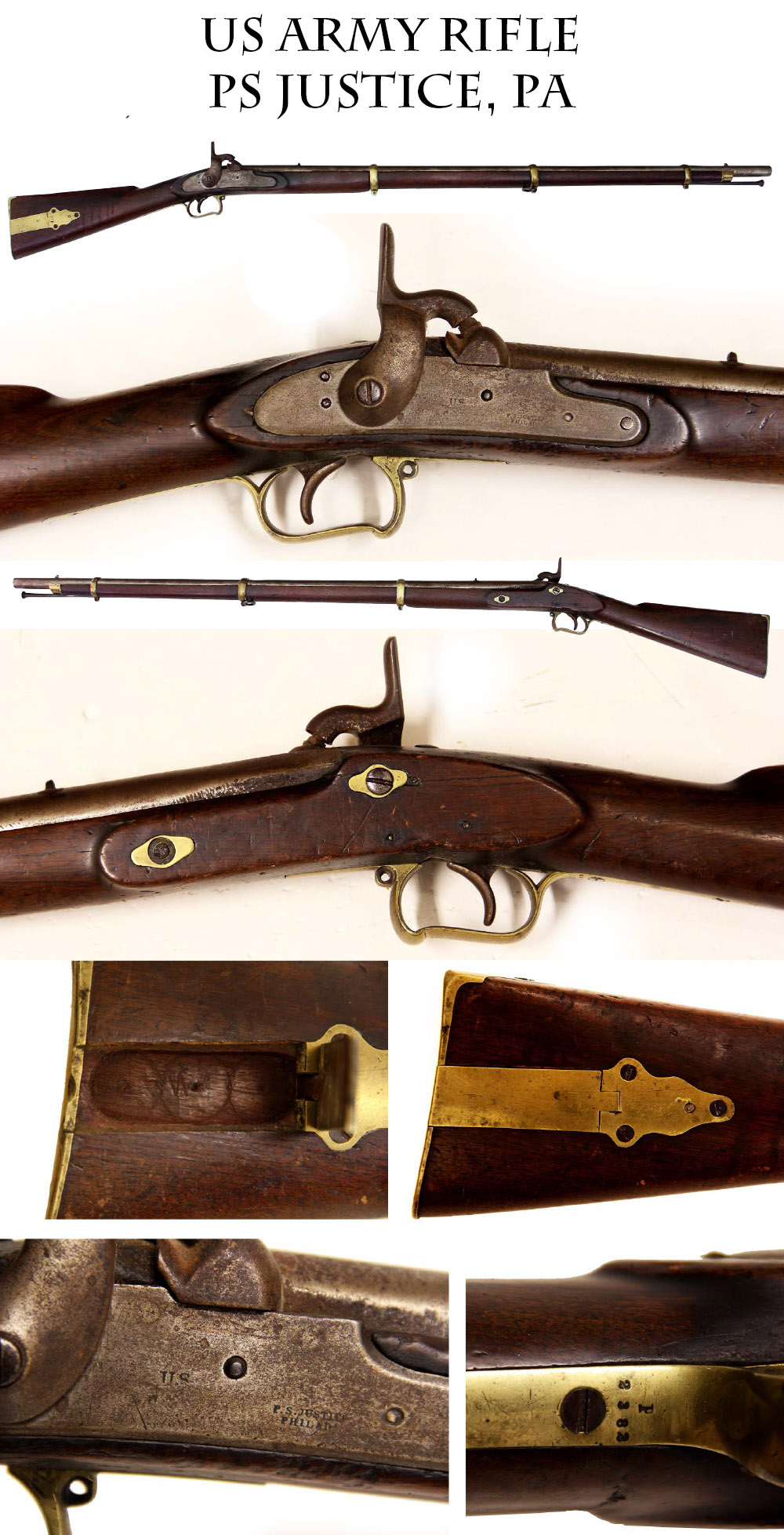
13-07-46 … 13-06-26 … P.S. Justice Rifle-Musket …
With the firing on Fort Sumter, P.S. Justice of Philadelphia raced to get arms into the hands of the early war volunteers, producing several variants of rifles and muskets. He turned out fewer than 5,000 guns in all, at first using a hodge-podge of surplus 1816 parts and then his own manufactured ones, but he got the job done and on time. This is termed the Type-III by collectors, brass mounted, with patch box and three barrel bands, .69 Caliber, and has the readily identifiable Justice double-curved trigger guard. US and PS Justice/ Philada. marked lockplate. Very nice looking overall. Lower sling swivel gone, as is the bayonet lug, otherwise complete. Ram rod is a button tip 1816 style as opposed to the tulip rod usually seen on Justice muskets. There is an even age toning on the barrel, silvery gray shifting to brown near the breech … Minor corrosion near nipple … vise marks on the left side of the breech … Lock, hammer and bolster are mottled gray with some brown undertones from faded casehardening. Mechanically good but no half-cock (full cock is fine), edges decent, just slight rounding from handling. Nearly invisible repaired MINOR crack where the wrist meets the breech. Forward lock screw is replaced with a non slotted screw or pin. That covers all the minor warts on this darn scarce musket. Nice medium patina on the brass. Marked with an M or W in the patch box which is a marking frequently seen on these, probably the surname initial of the stock maker. The use of a v-notch rear sight is unusual, but is like his Type-II musket. With Justice products, there are as many exceptions as there are rules. There is a serial number, 2382, stamped in the trigger guard. Many of Justices guns went to Pennsylvania troops, such as the 58th, 88th, and 98th PA Vols., and were the subject of some complaints at the time. However, students of American arms regard his products as worthy and well-intentioned. Justice succeeded in helping quickly arm troops in an emergency, and getting his weapons into the hands of troops by the end of 1861 … no mean feat. A solid, handsome, and scarce Pennsylvania musket
… $1,150.00 SOLD
Click Here to E-mail Us!
Call us @ 419-842-1863
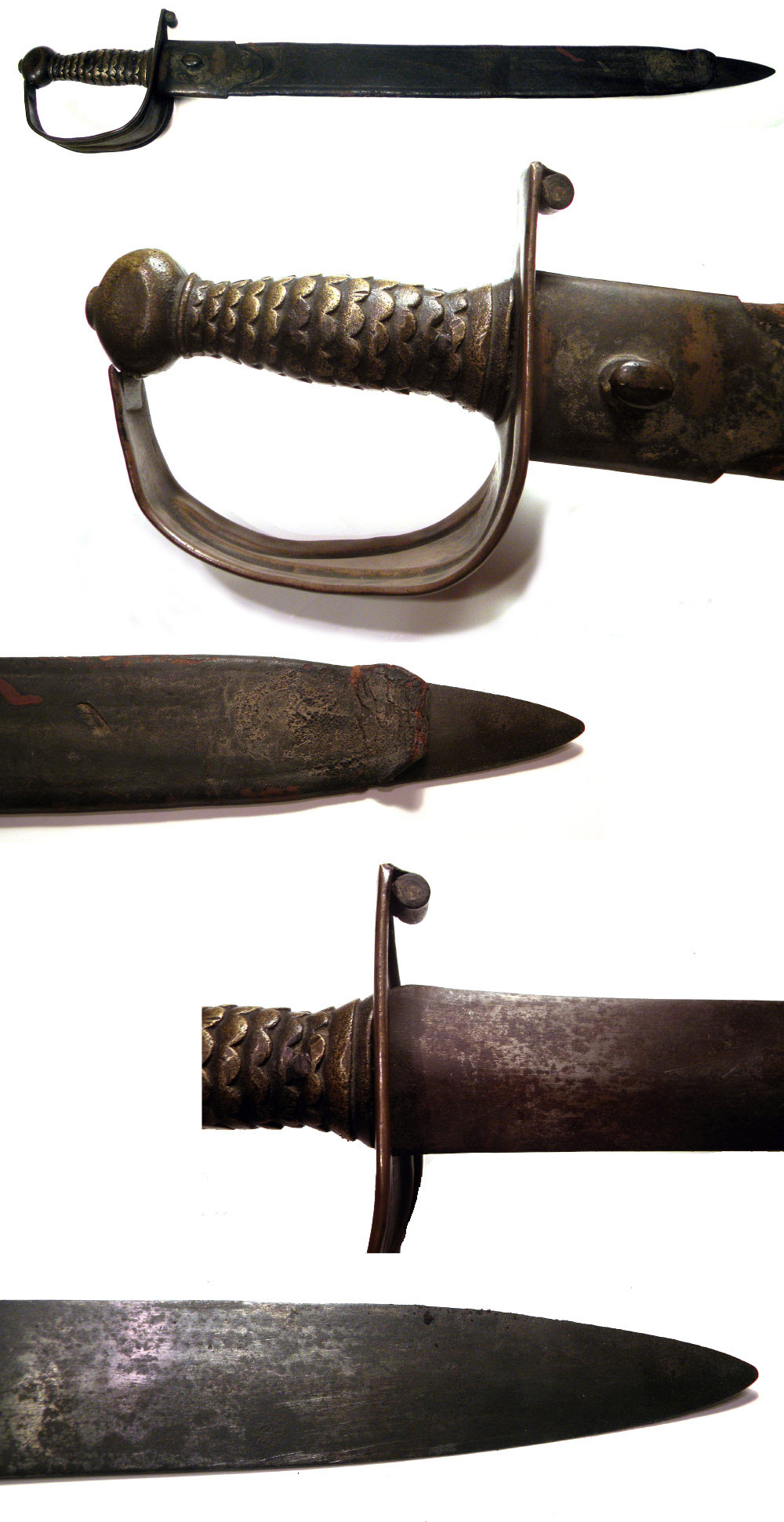
13-07-47 … 11-10-35 – Confederate Leech & Ridgon Navy Cutlass:
I obtained this fresh out of a house in western Pennsylvania just last week as I type this. It has never been on the collector’s market previously. What makes this weapon so wonderful is the presence of the original brass mounted leather scabbard. Solid cast brass handle. Ribbed brass guard. Nicely patinated steel blade. Brass mounted leather scabbard. Though all known specimens are unmarked, the cast grip and distinctive scabbard mount are quite obviously the product of Leech and Rigdon or Thomas Leech. Condition is attic fine. Quillon is severely bent (see photo). Drag on sheath is gone. Otherwise a superb specimen. 26.5 inches overall 21+ inch blade. Earlier this year I had a rare Leech & Rigdon Bowie knife incorporating the same handle and scabbard mount. A very desirable Confederate edged weapon and one never offered publicly on the collector market until this moment.
$4,500.00
Click Here to E-mail Us!
Call us @ 419-842-1863

THE PROBLEM:
A year ago, the VA, in effect, shut down its program, which has been in existence for more than a century, to mark the graves of veterans whose graves were unmarked. It ended that program by redefining applicant for a marker so narrowly that only direct descendants, rather than historians, cemeteries, museums, veterans associations, and concerned researchers, may apply for a marker. This is wrong.
THE SOLUTION:
Speak out now. Protest!
Sign our petition.
And spread the word. Call your members of Congress and tell them to support legislation to change this.
Help us Mark Their Graves!
at
www.marktheirgraves.org
Layaways are Welcome
Need to split your order into multiple payments? No problem! A simple 20% earnest money deposit will hold your item for you.-acf
You can then pay it off in easy installments that fit your budget.
Read Terms Here
Items to Sell? Contact Us
I am always interested in buying ANYTHING from the American Civil War… Guns, Swords, Civil War Muskets, Knives, Uniforms, Flags, Medals, Badges, Diaries, Letters, Autographs, Buttons, photographs, tintypes, daguerreotypes, Insignia, Camp Items, Battlefield Relics, canteens, Drums, Etc… Call 419-842-1863 and ask for Dave Taylor.

